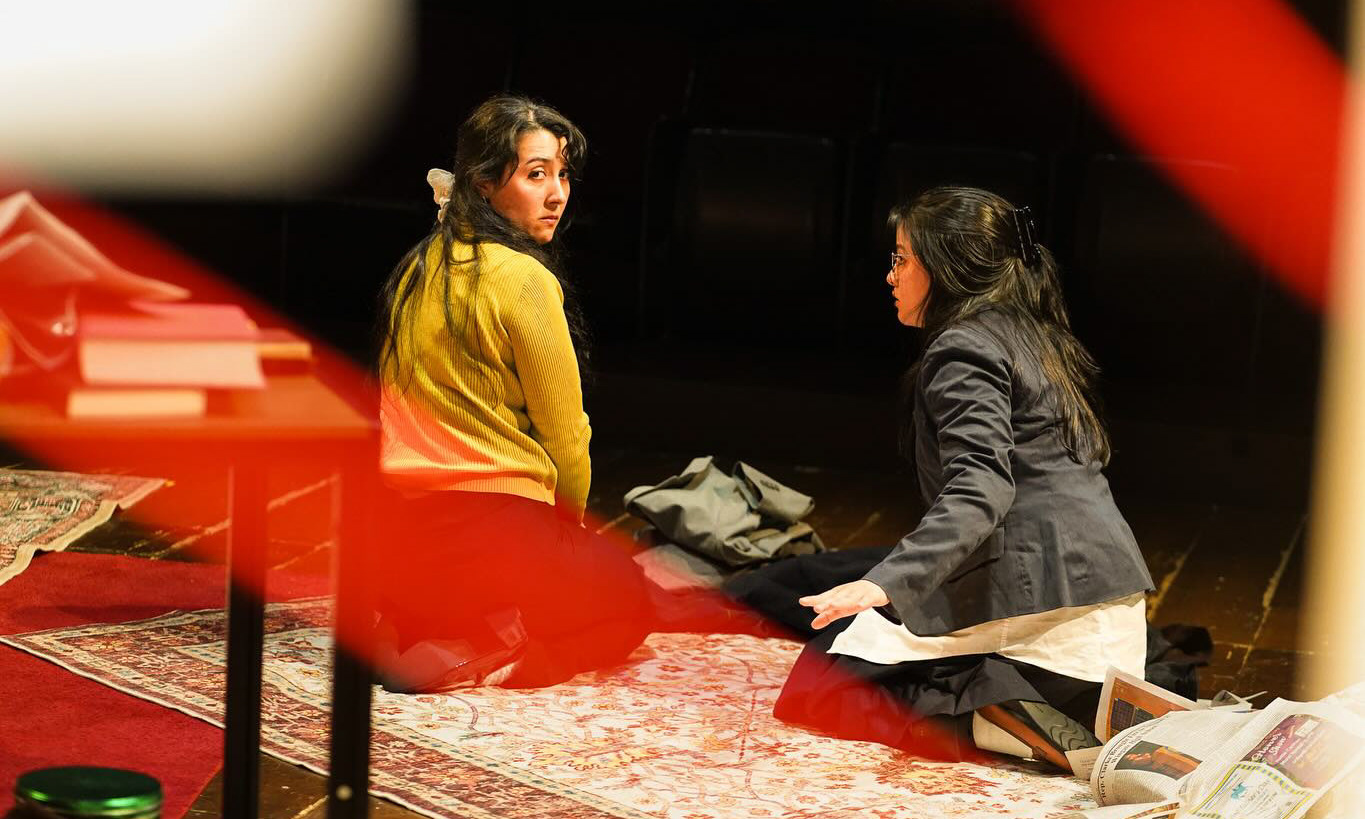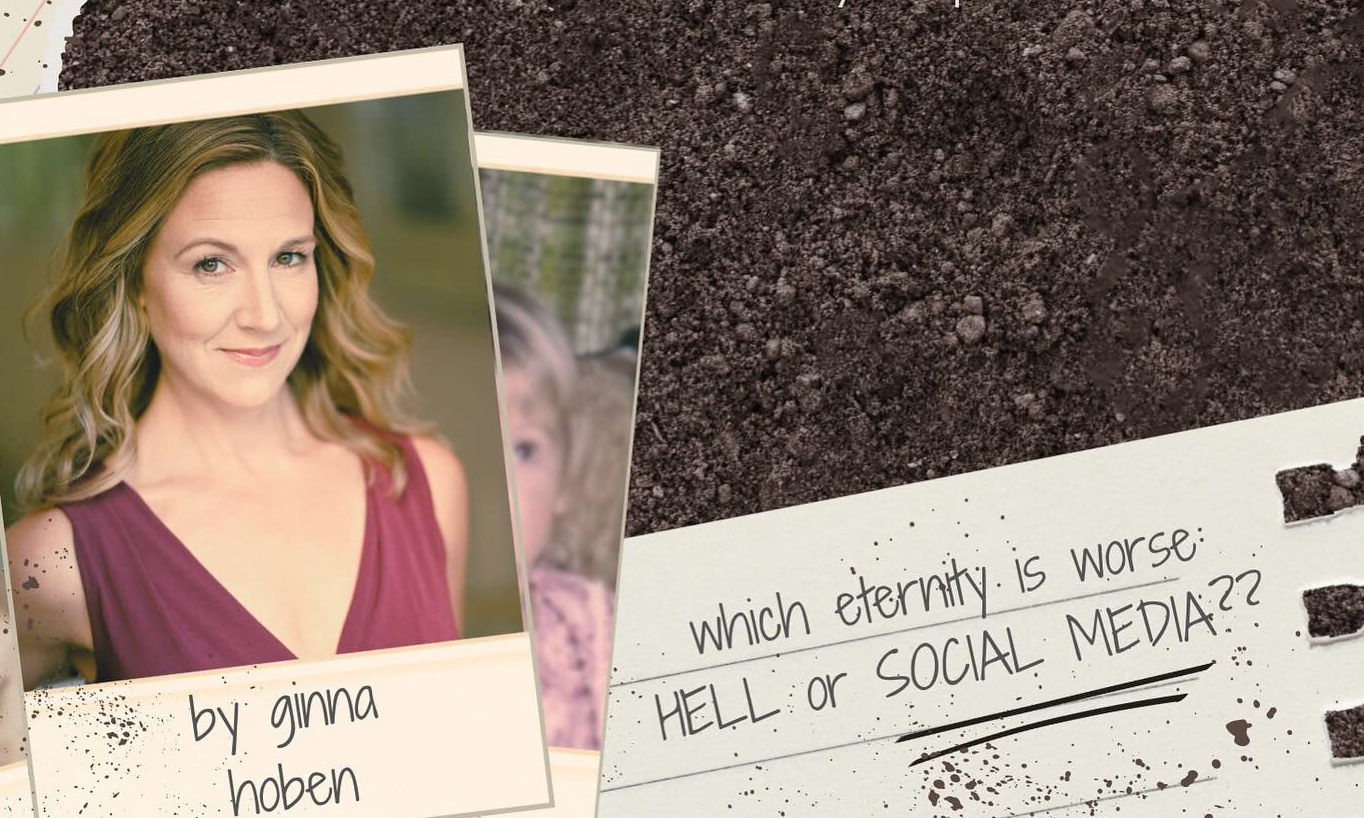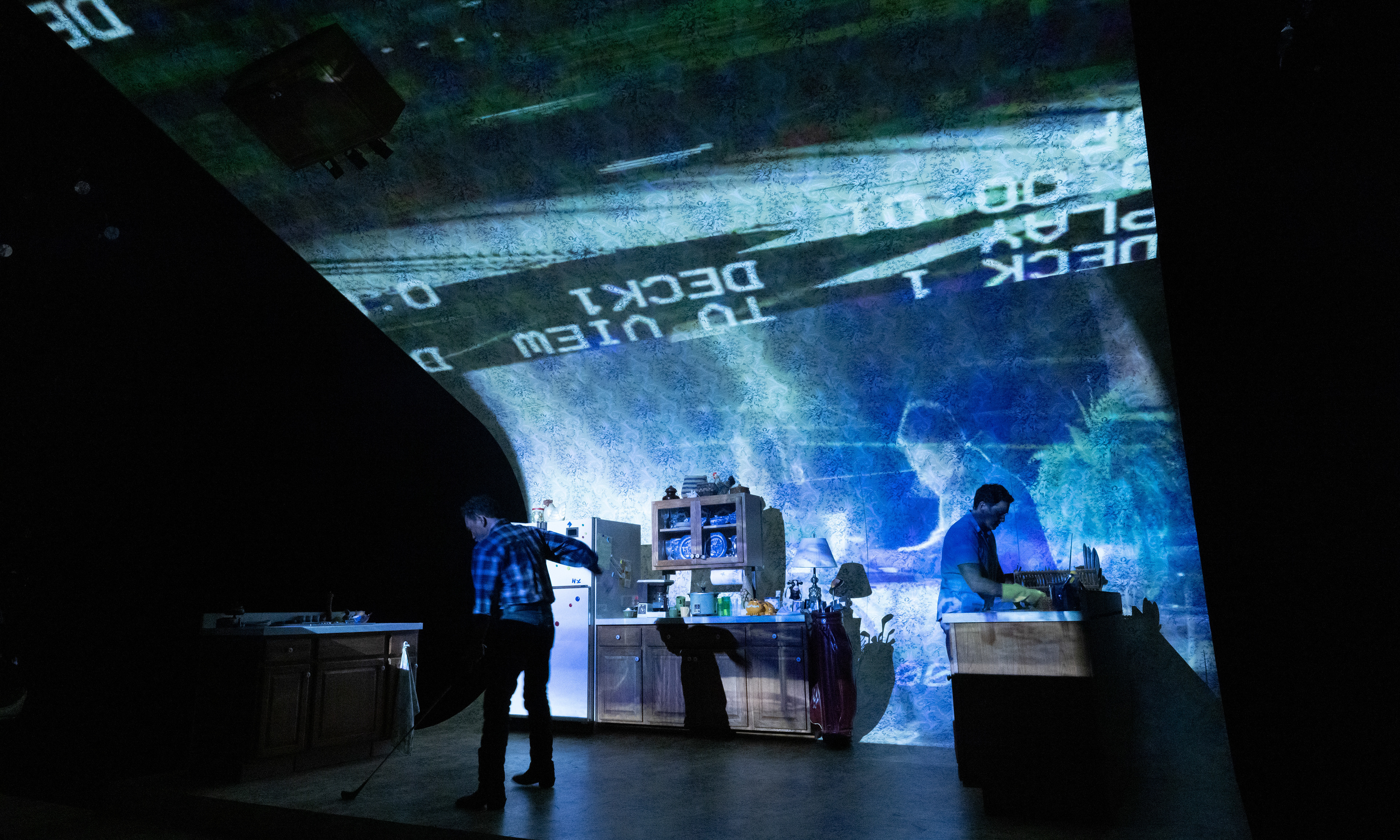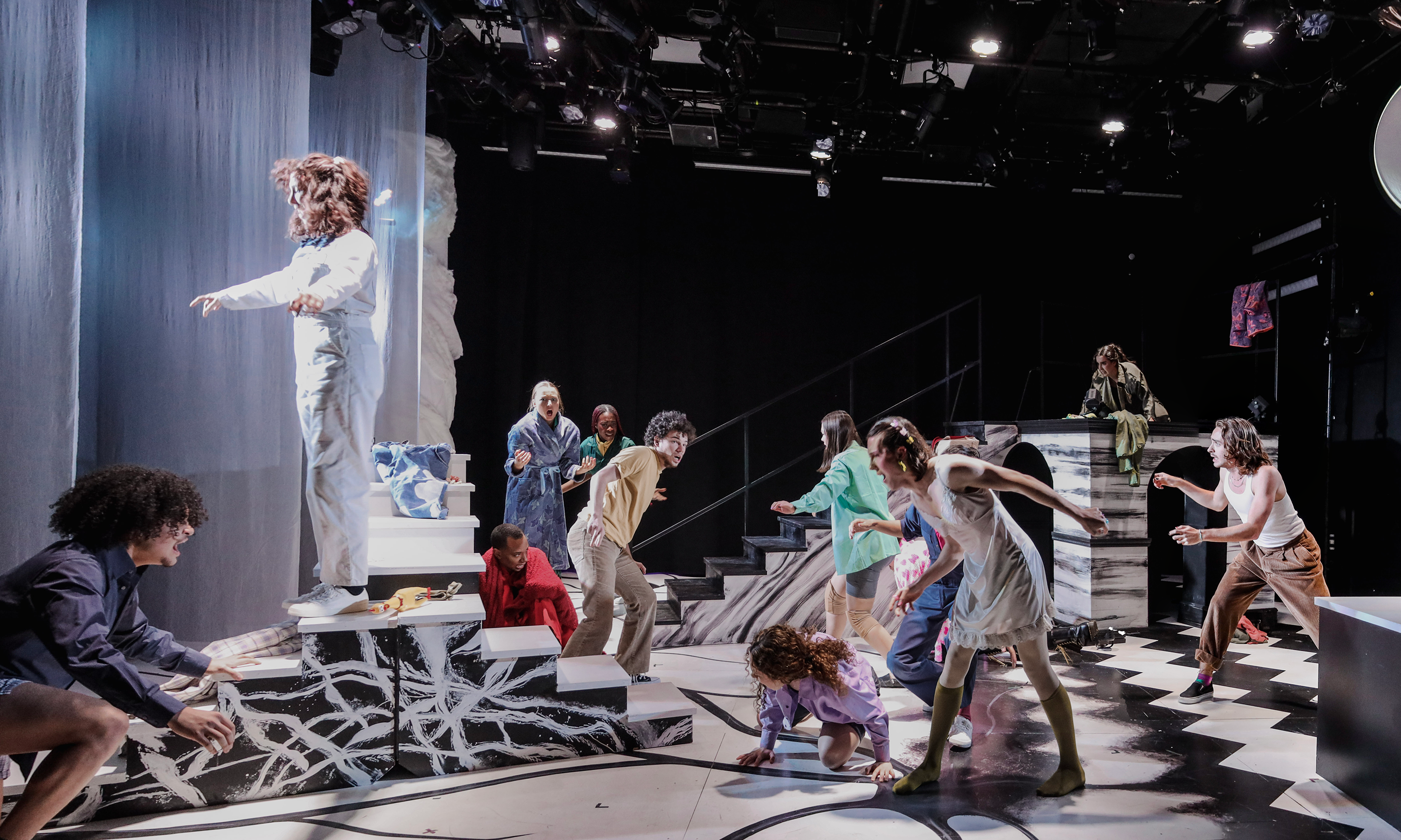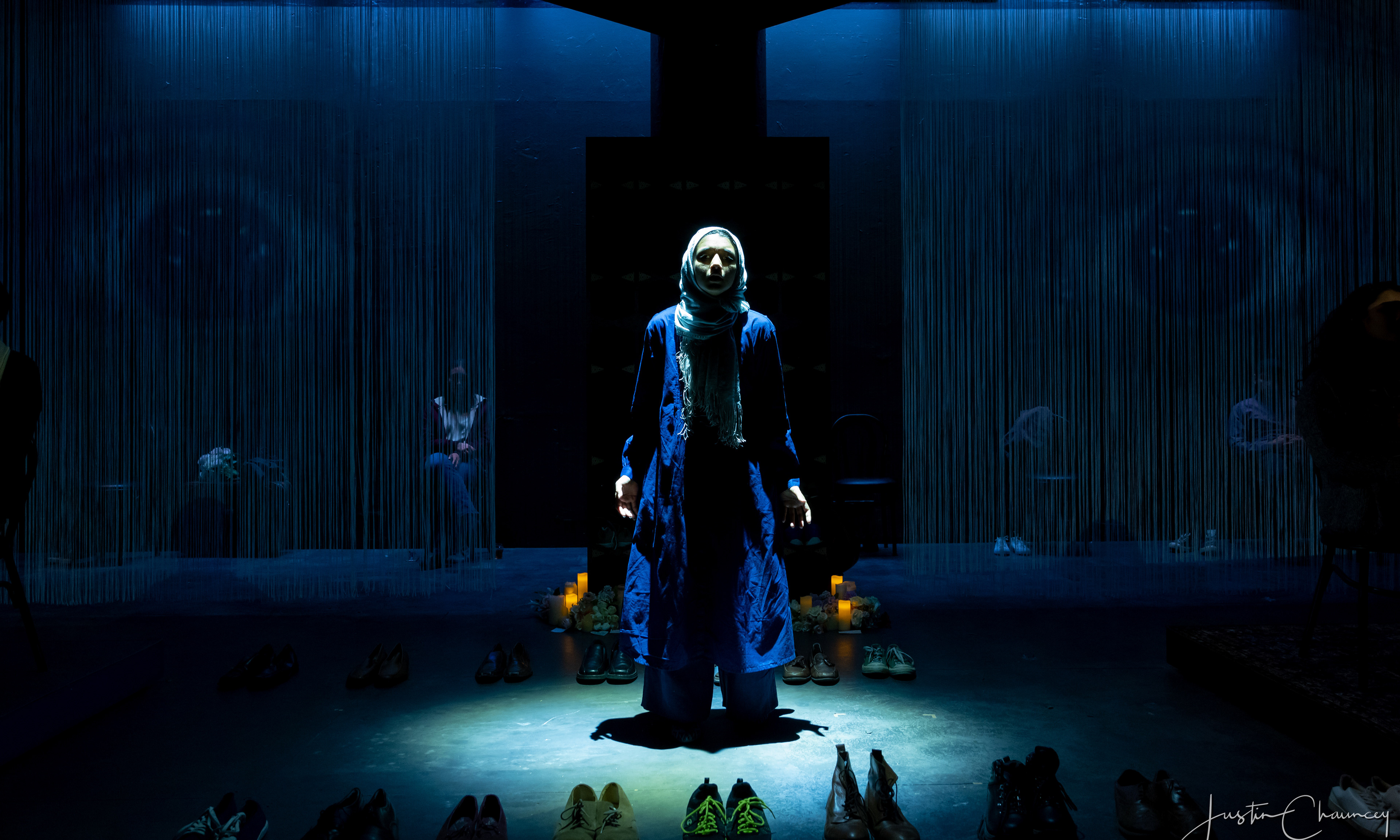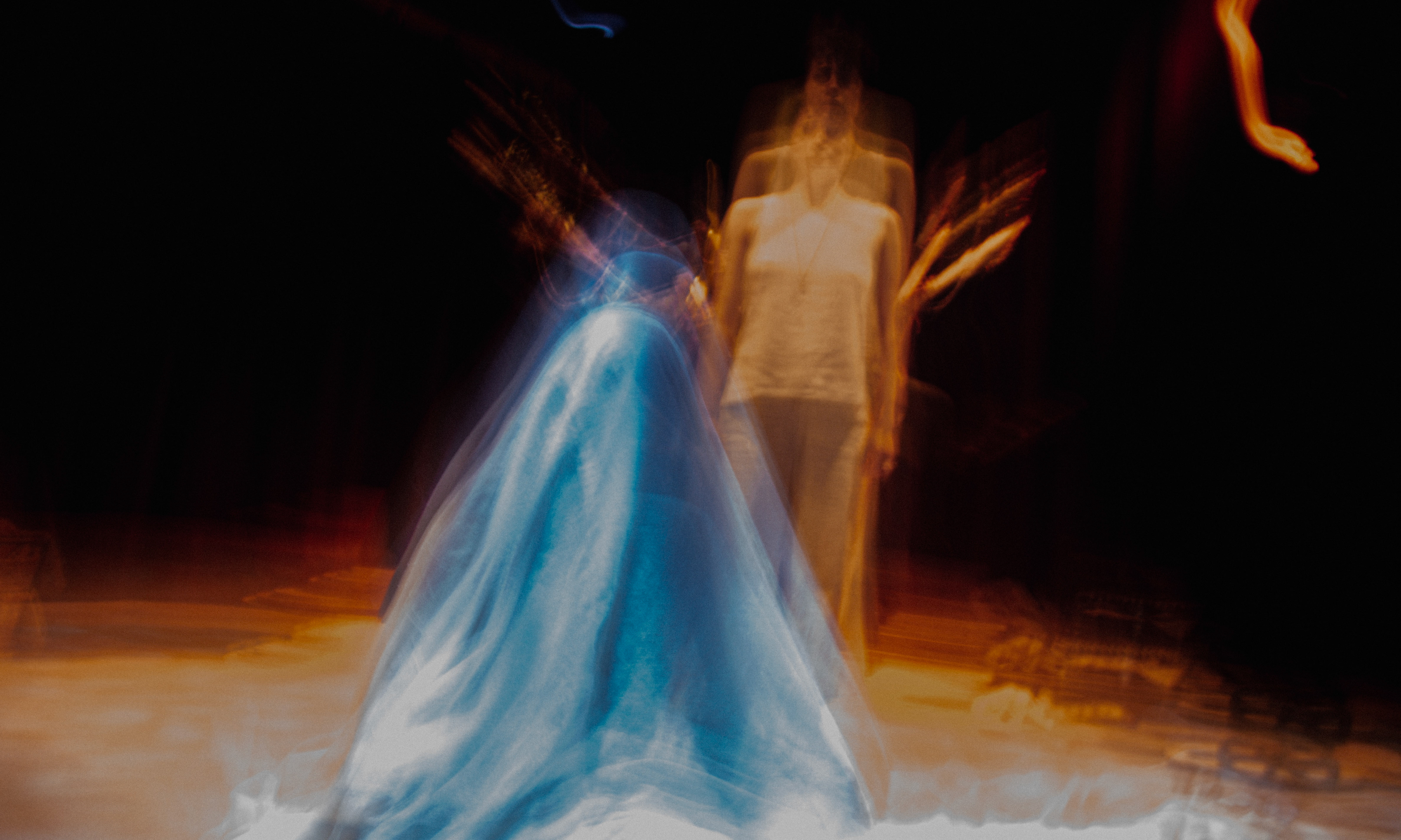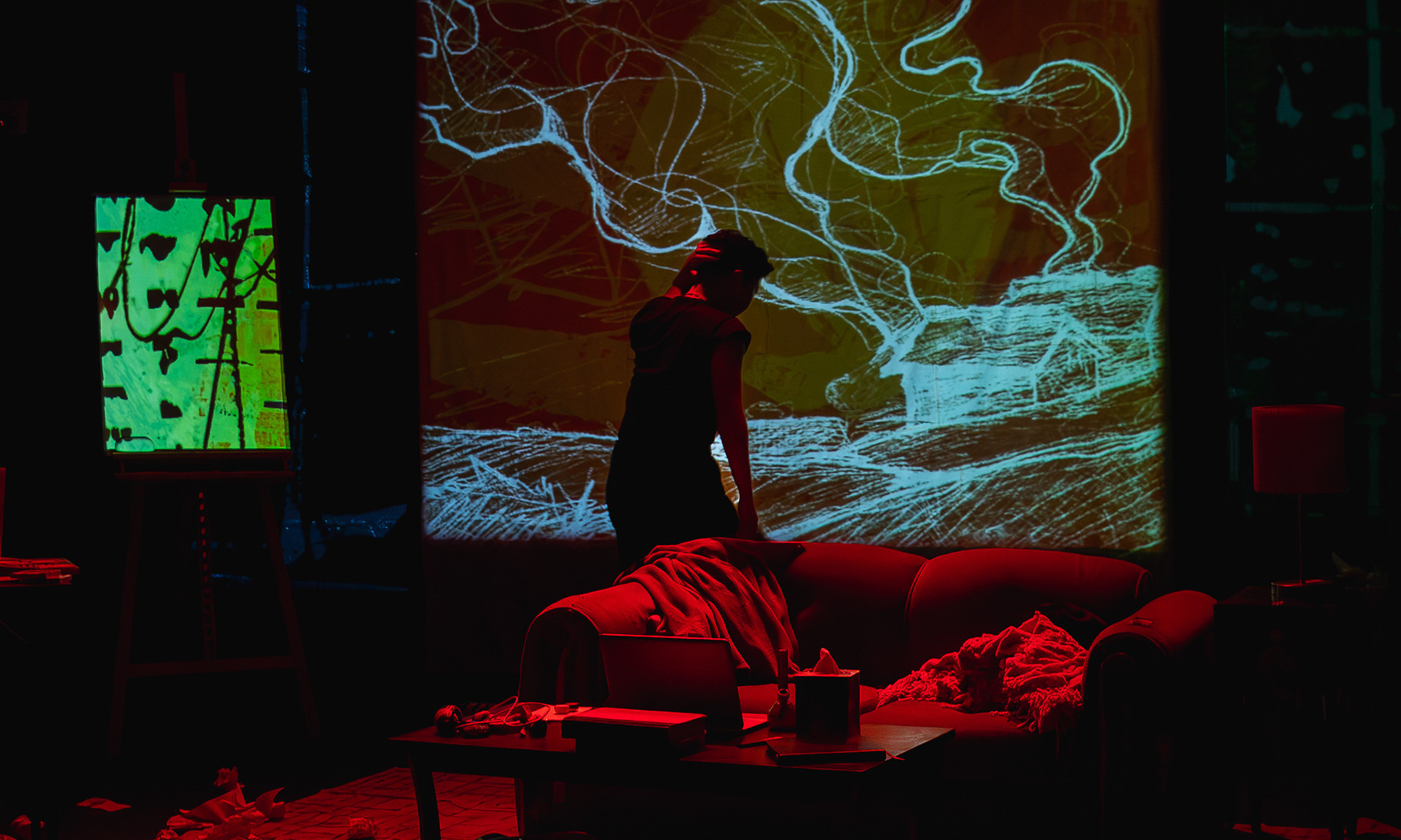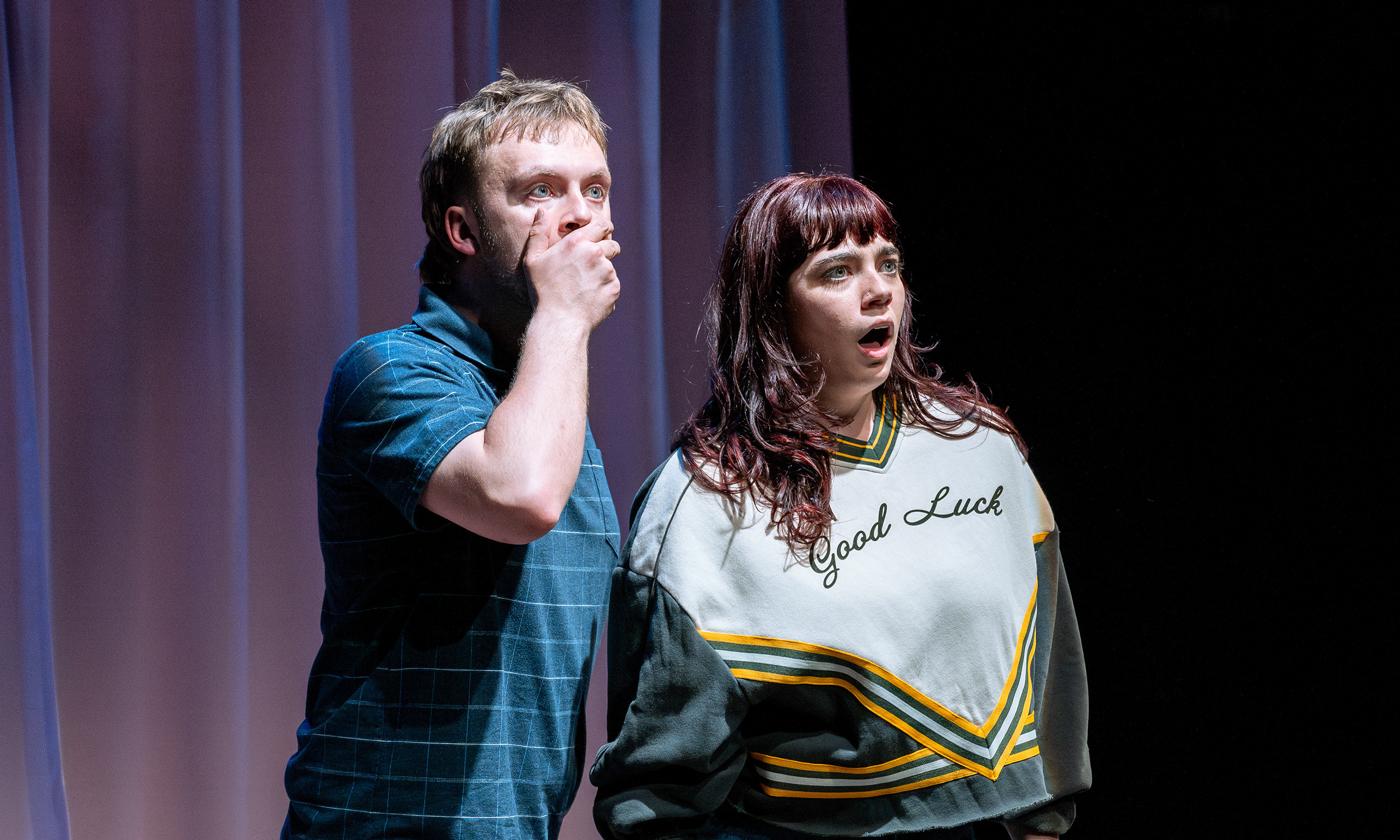Directed by NINA GOODHEART
written BY SOPHIE MCINTOSH
produced BY GOOD APPLES COLLECTIVE and ryan duncan-ayala
⚪️ ⚪️ ⚪️
CREATIVE TEAM
Scenic Designer junran "charlotte" shi
props Designer sean frank
Costume Designer saawan tiwari
Lighting Designer paige seber
Sound Designer MAX VAN
associate Director and dramaturg mia fowler
production Stage Manager damayanti wallace
assistant Stage Manager Jenna rowell
intimacy and fight director willow funkhouser
associate producer Sarah jones
⚪️ ⚪️ ⚪️
CAST
JAKI MIA SINCLAIR JENNESS
OWEN D.B. MILLIKEN
NEIL/MILES MICHAEL LEPORE
UNDERSTUDY JAKI ANNA AUBRY
UNDERSTUDY OWEN/NEIL/MILES NICHOLAS LOUIS TURTURRO
WITH THE VOICEOVER CAST BELOW
⚪️ ⚪️ ⚪️
SUMMARY
What happens to the stains you can’t get out?
Owen is a roadkill collector. Jaki was busted for drunk driving. And for the next six Saturdays, they’re stuck with each other. As they traverse the highways of Wisconsin, they connect over their common ground as outsiders, challenge each other on issues of faith and family, and careen towards a collision that threatens to shatter them both. Sophie McIntosh’s unflinching new play Road Kills forces us to confront the long-lasting repercussions of abuse — and urges us not to look away.
More info HERE

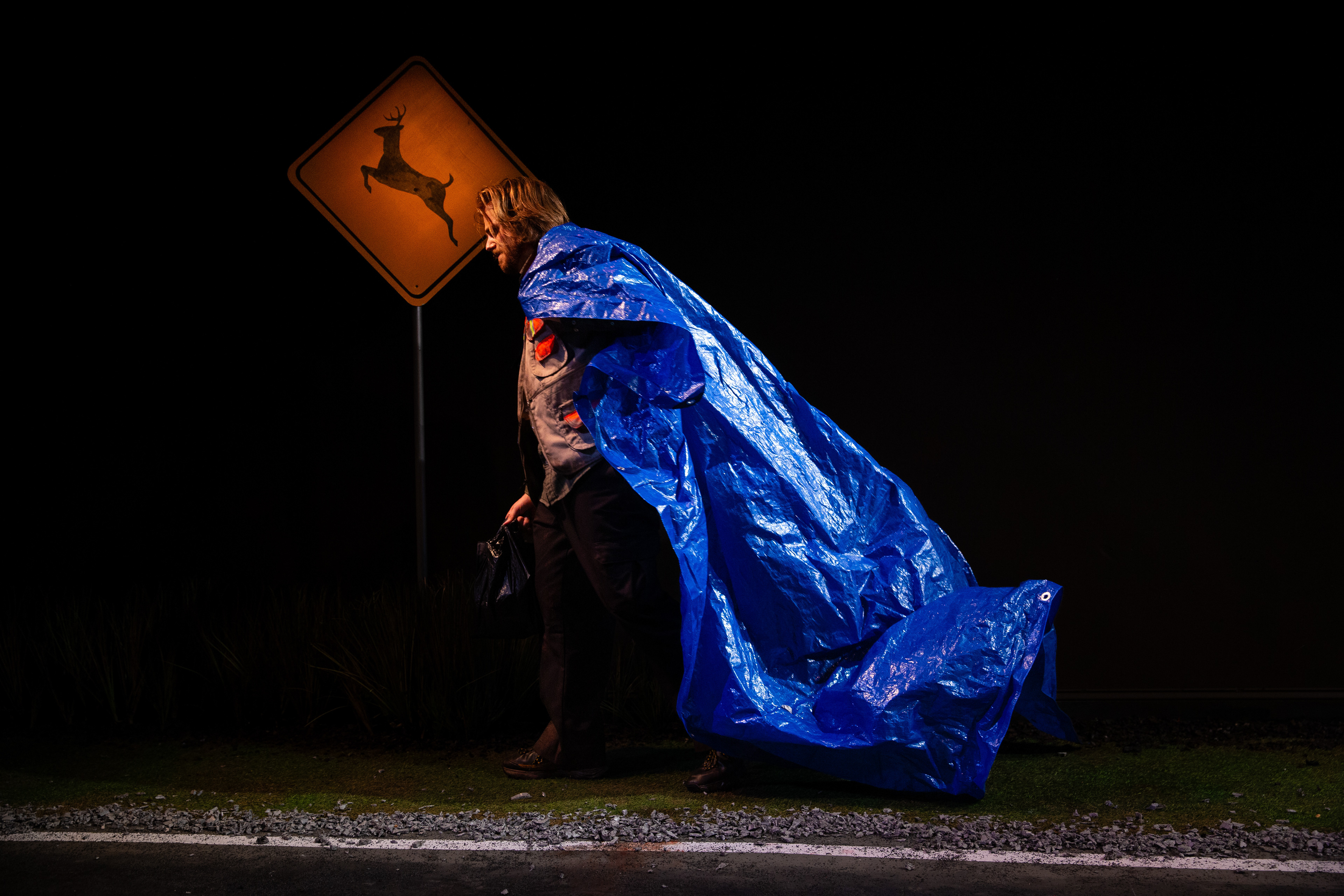

SYSTEM SETUP & DESIGN CONCEPT
In the true fashion of my second Good Apples Collective production, the audience configuration is once again wider than it is deep, placing the audience's experience of watching from the side of the road. Now, the first simple system set-up is an LRC experience. However, stopping there would not do this play justice; I knew that I wanted to pull the sound imaging down. By hiding two JBL Control 2P in the tall grass bushes on stage, we were teasing a sense of life beyond the asphalt – waiting for the lights to dim before they could come out.
I was gifted with Sophie McIntosh's scene transitions as mini-radio episodes, revealing how the roadkill demise occurred before Jaki and Owen come for the pickup in the next scene. Paired with Paige Seber's lighting design, I wanted this transition to emphasize the naturalism sound imaging, and shift the audience's listening experience – from side of the road to hitchhiking in the backseat of someone's vehicle – from passive to active.
All of the voice-over recordings were done with two SM57s connected to the Zoom H5 as an audio interface and directly recorded to Logic Pro. A make-shift recording studio was set up in our rehearsal room, which doubled as a surf class studio in the evenings, hence the background wetsuit in the image below. All of our voice-over performers were absolute delights! The collaboration between Nina, Sophie, the performers, and me was charmingly playful.
SOUND DESIGN HIGHLIGHTS
FOR A BETTER EXPERIENCE, LISTEN WITH HEADPHONES*
Note that original spatialization has been adapted for this demonstration.
DECOY TRANSITION – PERFORMED BY, WILL WEGNER AND MICHAEL ORTIZ
BUCK TRANSITION – PERFORMED BY, EDGAR MCINTOSH AND NATASHA PARTNOY
TRANSITION BREAKDOWN
Most of the transition follows a formula,
Night Ambience > Specific animal moving in the bushes > Car Approaching >> POV moves inside the car >> VO sequence >> Car Skids Away > Back to night ambience >> Whoosh into next scene > A specific bird calls to open the scene.
The specificity of the animals before and after the transitions acts as a foreshadowing device. For example, in the BUCK transition, I placed a buck moving in the bushes towards the doe's call, which later becomes the road kill in the transition. I opened the next scene with Chickadees. The birds are specific to the dramaturgical dynamic that will unfold in the scene.
THE BIRDS OF ROAD KILLS
Special shout-out to Cornell Lab's All about Birds, which helped me dive deep into Wisconsin ornithology!
1. FAWN — Yellowlegs
What bird: A solitary shorebird known for bright yellow legs and sharp, alarm-like calls.
Why chosen: Its strident “tattler/yelper” call echoes Jaki’s hard edges and the warnings built into her personality.
How it works in the scene: Represents Jaki’s first impression—striking, alert, and shaped by past harshness. She moves through the world on guard, broadcasting danger before anyone can get close.
Why chosen: Its strident “tattler/yelper” call echoes Jaki’s hard edges and the warnings built into her personality.
How it works in the scene: Represents Jaki’s first impression—striking, alert, and shaped by past harshness. She moves through the world on guard, broadcasting danger before anyone can get close.
2. SKUNK — Dark-eyed Junco
What bird: Small songbird with crisp markings and flashy white tail feathers.
Why chosen: Known for being easily recognized.
How it works in the scene: Mirrors how Jaki is publicly identifiable from the family billboard—instantly spotted, even when she doesn’t want to be.
Why chosen: Known for being easily recognized.
How it works in the scene: Mirrors how Jaki is publicly identifiable from the family billboard—instantly spotted, even when she doesn’t want to be.
3. BITCH 1 — Red-winged Blackbird
What bird: Males puff up, flare their bright red patches, and display aggressively to claim space.
Why chosen: Highly territorial, confrontational, and visually assertive.
How it works in the scene: Jaki embodies the male behavior—projecting dominance, intimidating others, using her own volatility and presence as armor.
Why chosen: Highly territorial, confrontational, and visually assertive.
How it works in the scene: Jaki embodies the male behavior—projecting dominance, intimidating others, using her own volatility and presence as armor.
4. DOE — Cedar Waxwing
What bird: Sleek berry-eater with mysterious red “wax tips” used for attracting mates; feathers change color based on diet.
Why chosen: Symbolizes how environment shapes outward identity and desirability.
How it works in the scene: Highlights the discussion around relationships, attraction, and the way people absorb their surroundings. Also nods to toxicity—waxwings literally get drunk off fermented berries (alcoholism metaphor).
Why chosen: Symbolizes how environment shapes outward identity and desirability.
How it works in the scene: Highlights the discussion around relationships, attraction, and the way people absorb their surroundings. Also nods to toxicity—waxwings literally get drunk off fermented berries (alcoholism metaphor).
5. DECOY — Northern Cardinal
What bird: A bright, non-migratory bird that stays vivid year-round; notorious for attacking its own reflection.
Why chosen: Represents steadfastness, territory defense, and internal conflict projected outward.
How it works in the scene:
Why chosen: Represents steadfastness, territory defense, and internal conflict projected outward.
How it works in the scene:
•Owen’s path: He stayed put, never straying far from what he knew.
•Owen’s protectiveness: Fiercely defensive, to the point of self-harm.
•Jaki’s defensiveness: She also attacks “reflections”—threats that are often really herself.
6. BUCK — Chickadee
What bird: Known for nesting in hard-walled spaces and having a memorable, distinctive call.
Why chosen: Builds safety by walling inward; pressure accumulates in enclosed, internal spaces; remembers everything, even what’s painful; their calls have a nostalgic quality.
How it works in the scene:
Why chosen: Builds safety by walling inward; pressure accumulates in enclosed, internal spaces; remembers everything, even what’s painful; their calls have a nostalgic quality.
How it works in the scene:
•Jaki: Her biggest threats come from “inside the wall”—family, Miles, her past. The pressure has nowhere to go.
•Owen: Also self-walled, trapped by shame and fear.
•Together: Their calls are unmistakable to each other—recognition through shared entrapment.
7. BITCH 2 — Cedar Waxwing + Red-wing Hybrid
Why chosen: A combined symbol of environmental influence (Waxwing) and volatile dominance (Red-wing).
How it works in the scene: Reflects a character shaped by her environment and willing to assert herself aggressively—an echo and escalation of the earlier archetypes.
How it works in the scene: Reflects a character shaped by her environment and willing to assert herself aggressively—an echo and escalation of the earlier archetypes.
8. Epilogue — Blue-gray Gnatcatcher
What bird: A small, gray bird known for mixing other birds’ songs—nicknamed the “Little Mockingbird.”
Why chosen: Blending, adaptation.
How it works in the scene: Suggests reflection, repetition, and the idea that what came before echoes into what comes after—someone picking up and remixing the sounds/stories of the others.
Why chosen: Blending, adaptation.
How it works in the scene: Suggests reflection, repetition, and the idea that what came before echoes into what comes after—someone picking up and remixing the sounds/stories of the others.
PERFORMANCE PHOTOS
PHOTOS TAKEN BY NINA GOODHEART

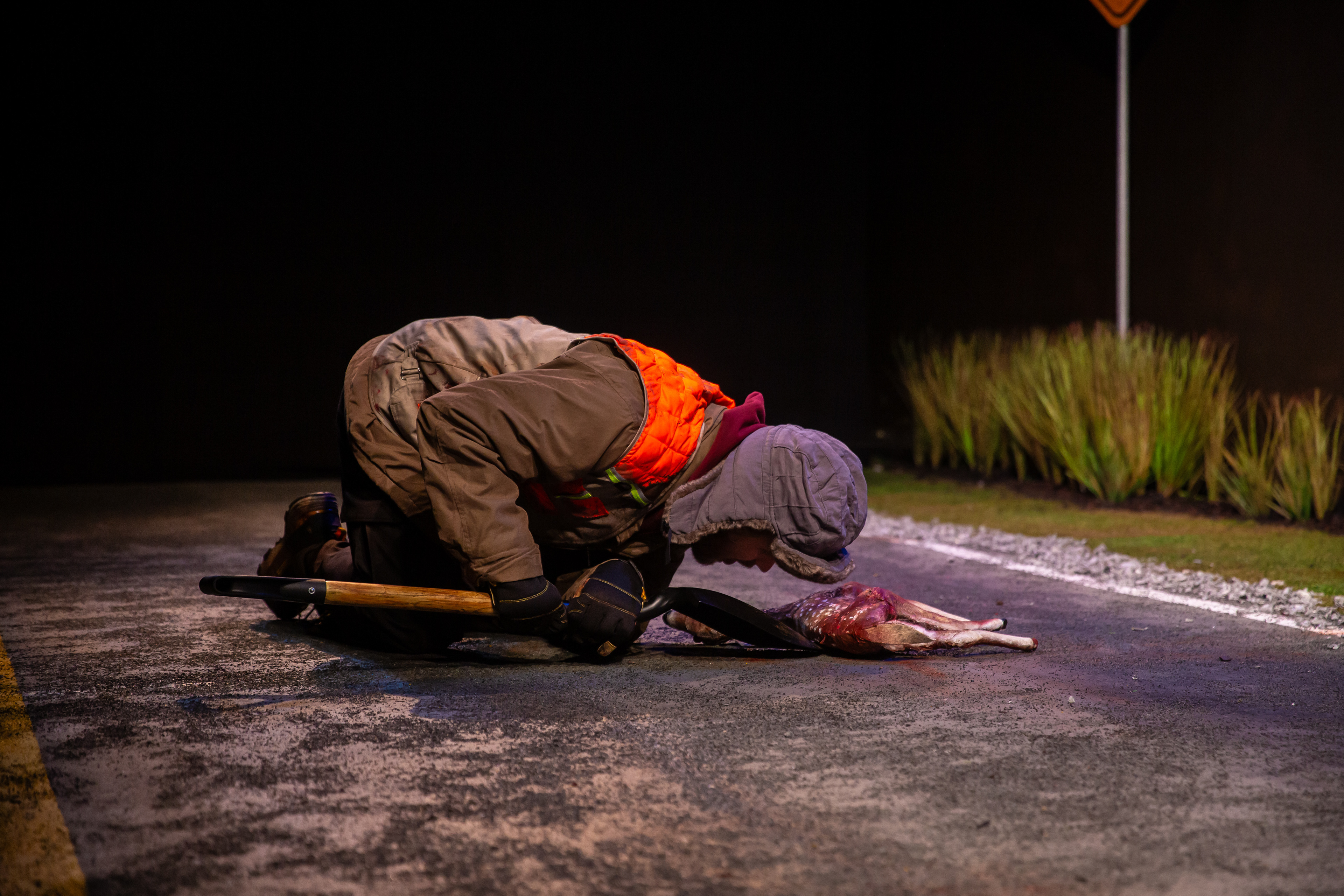
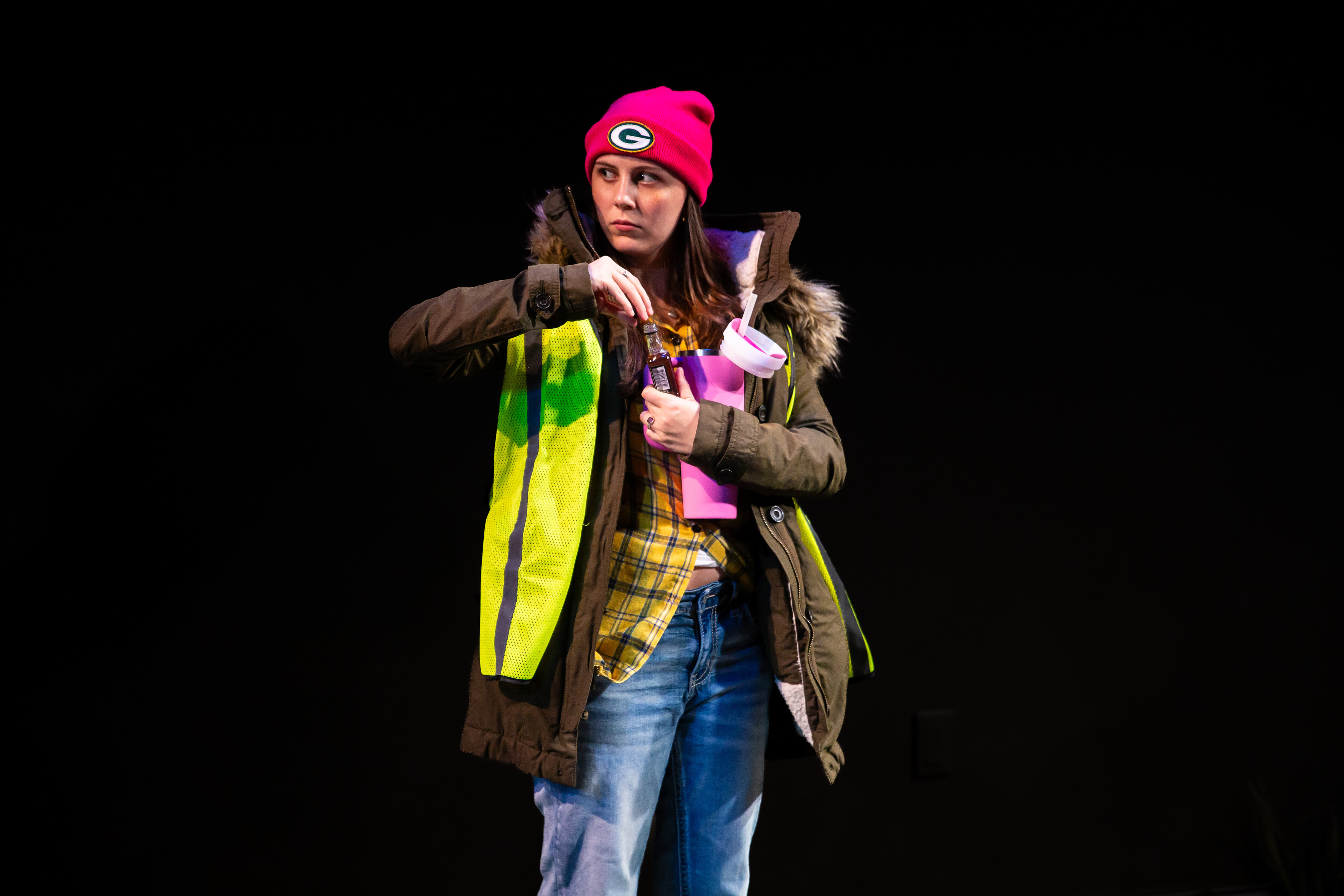

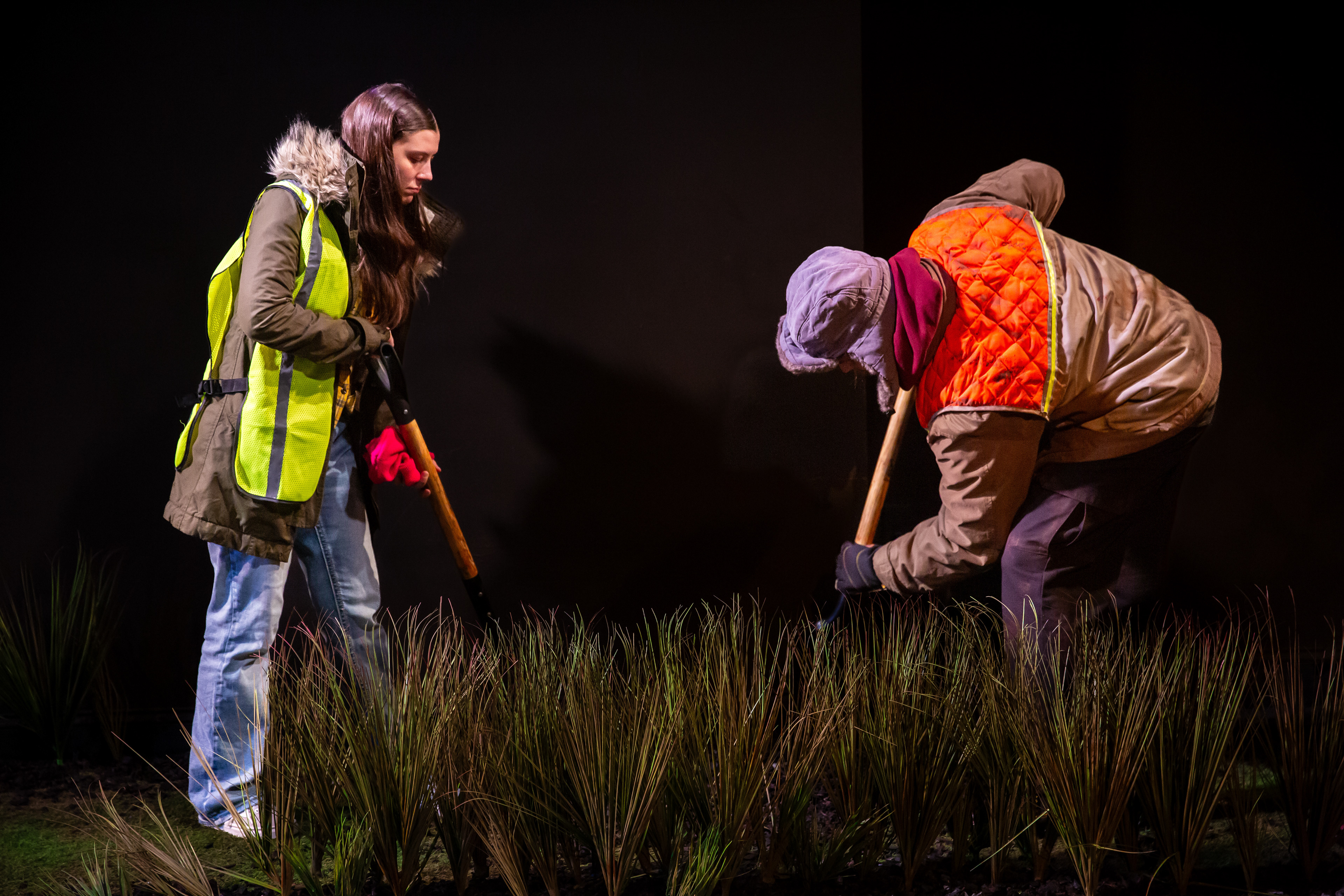
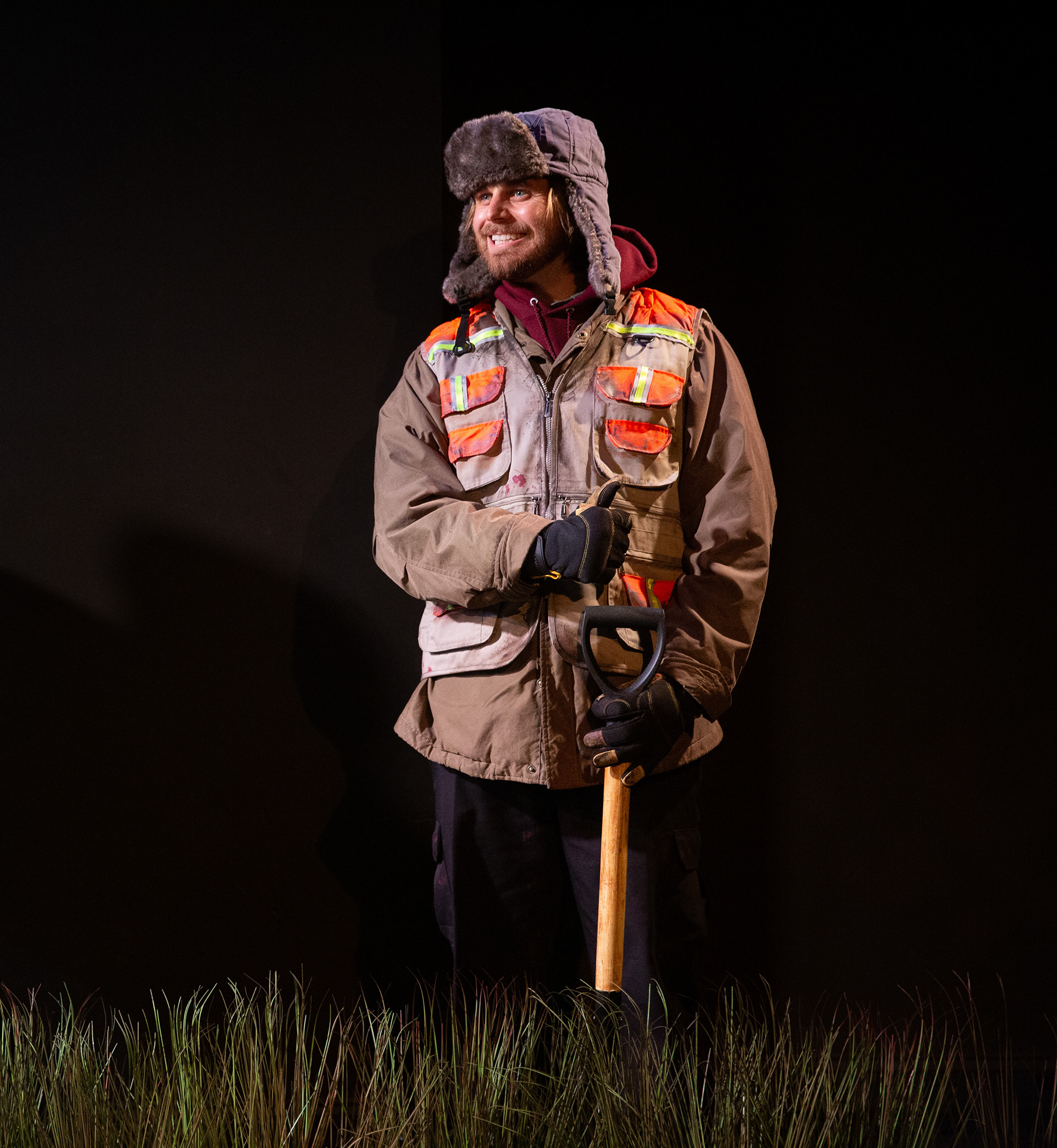


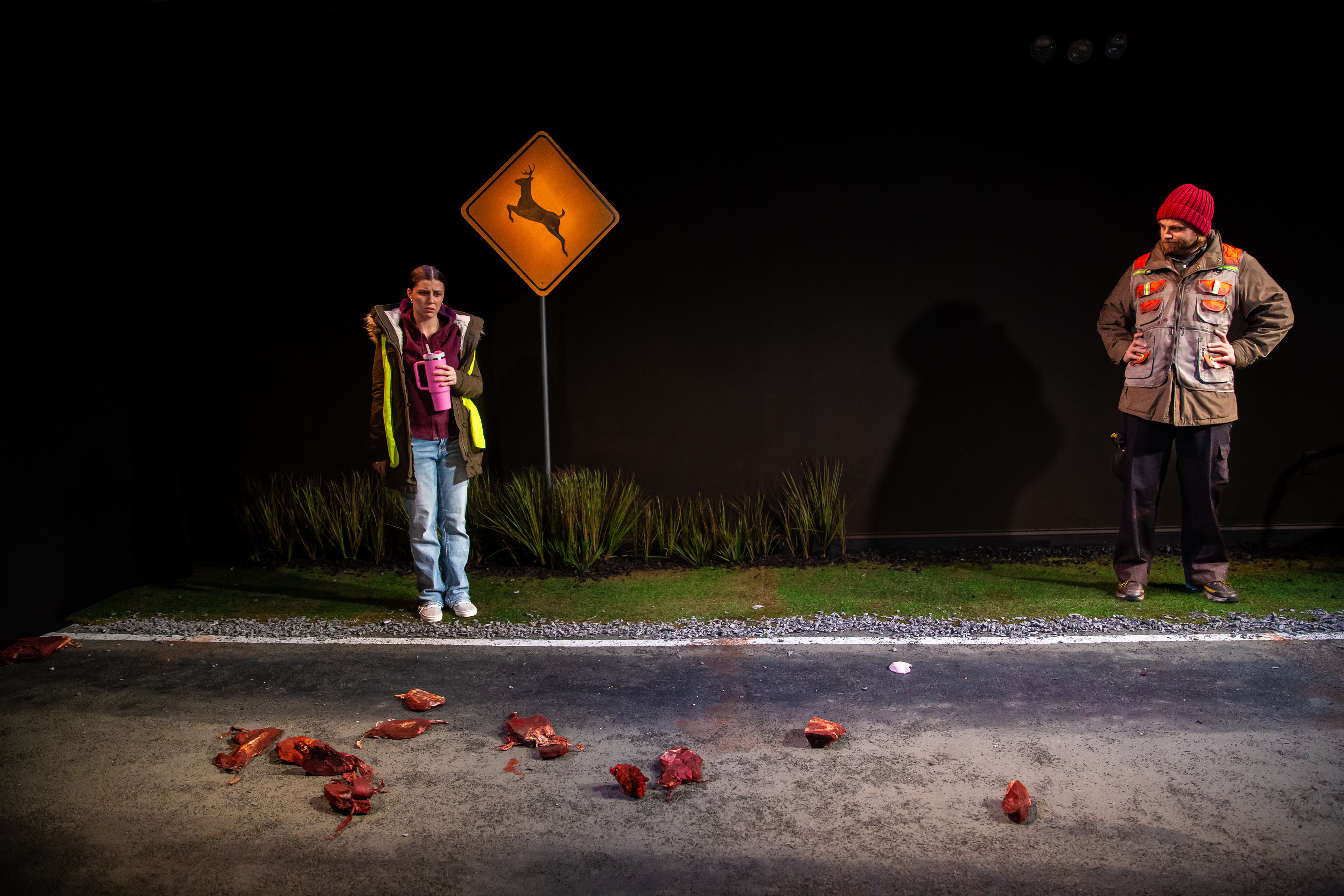
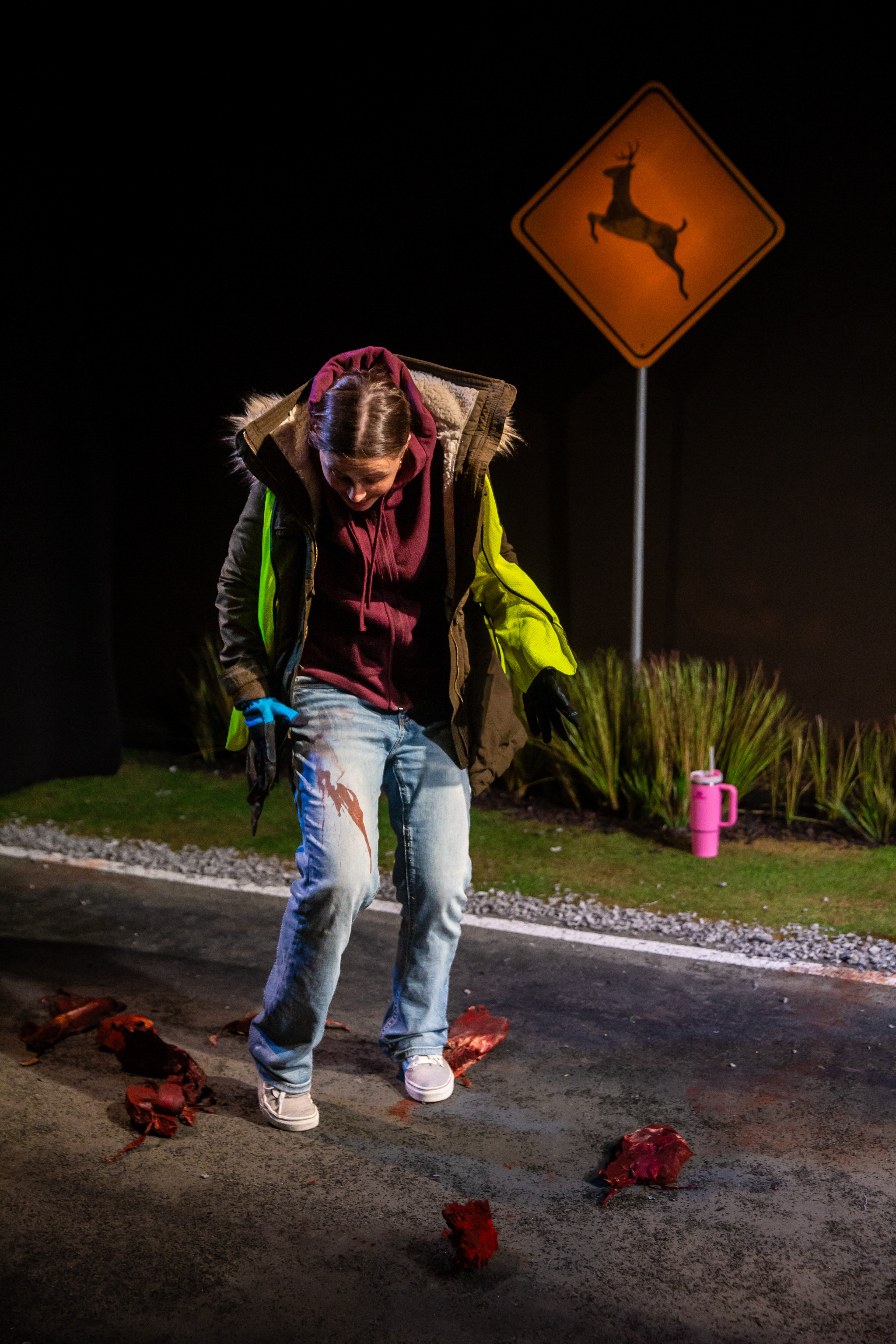

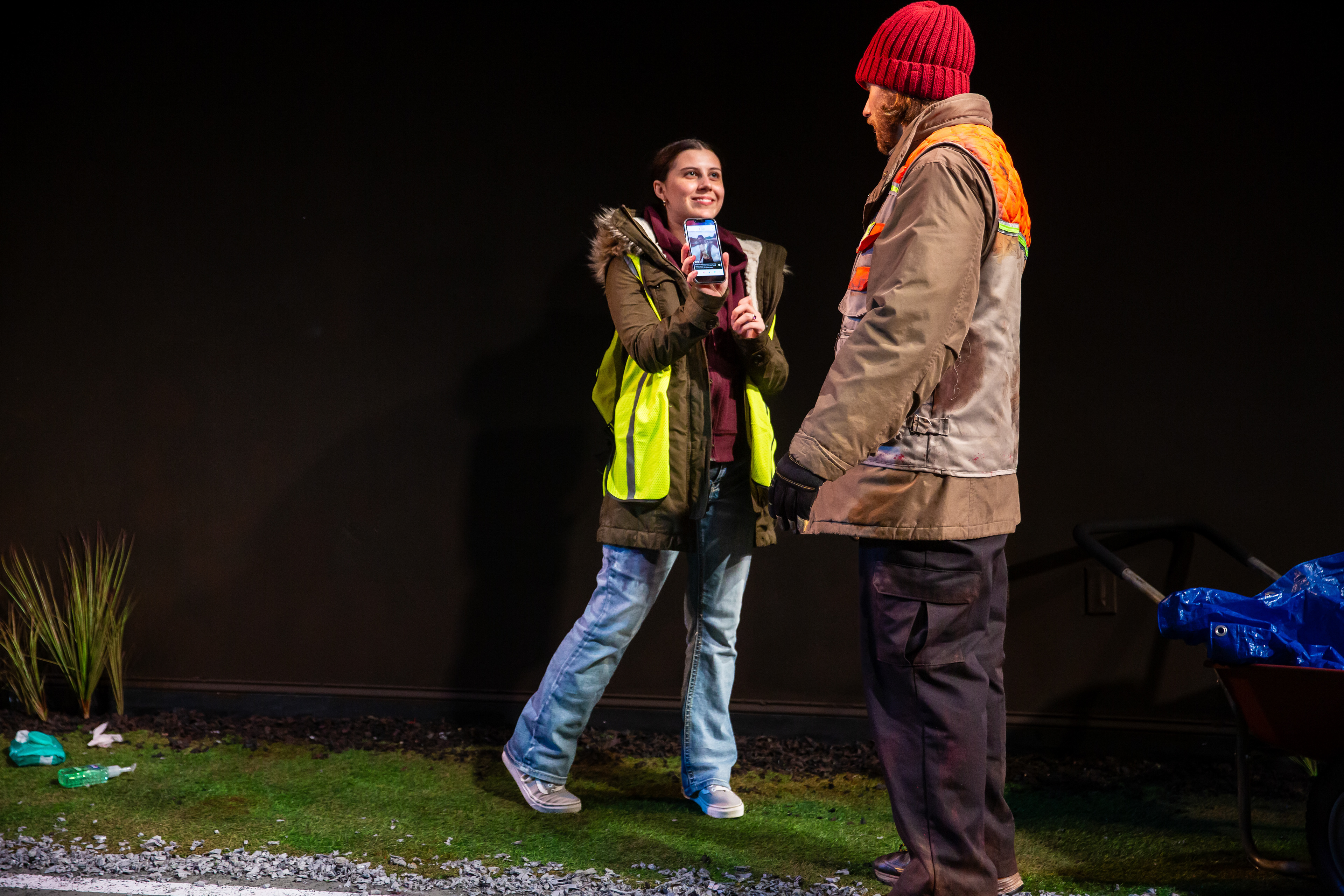
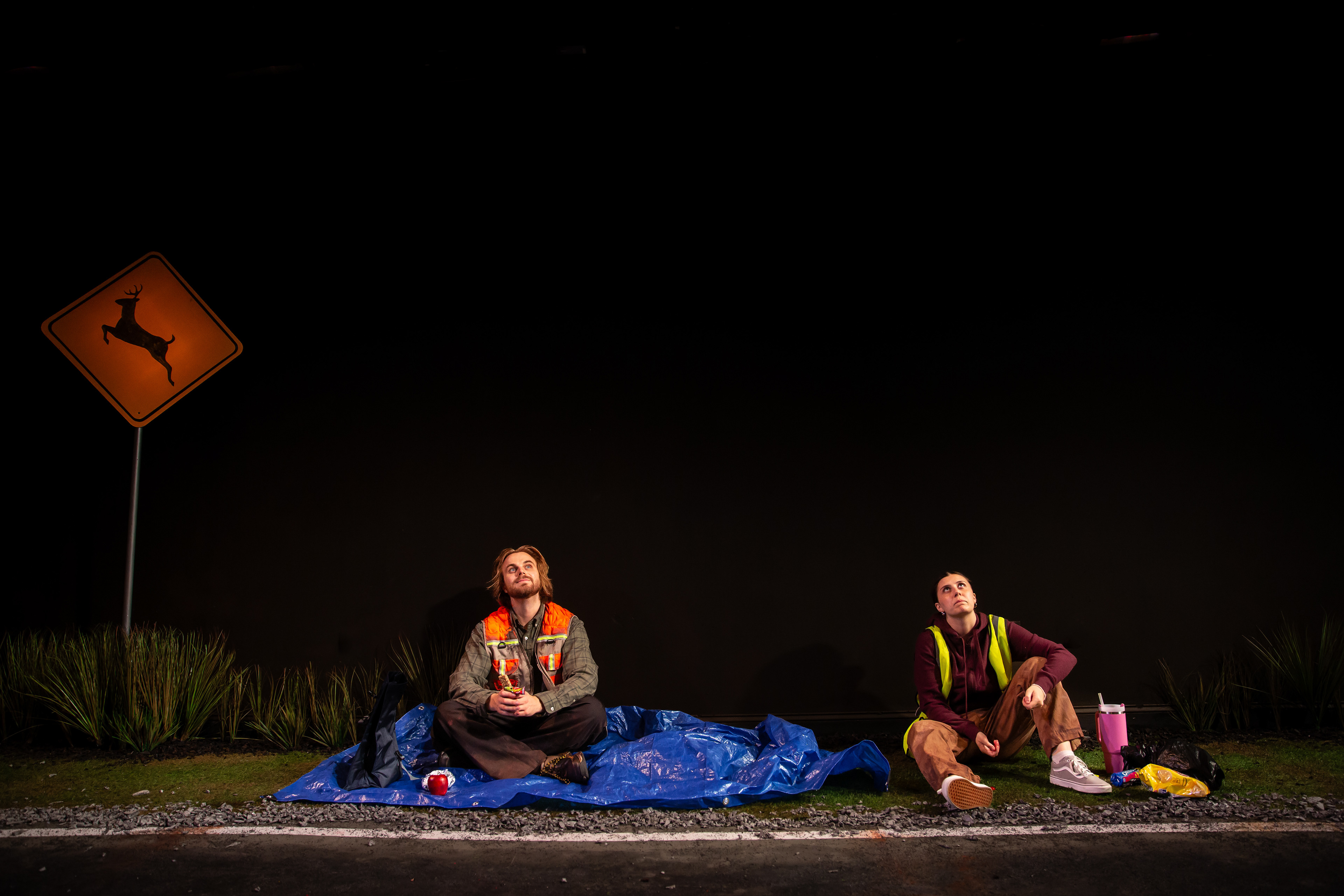

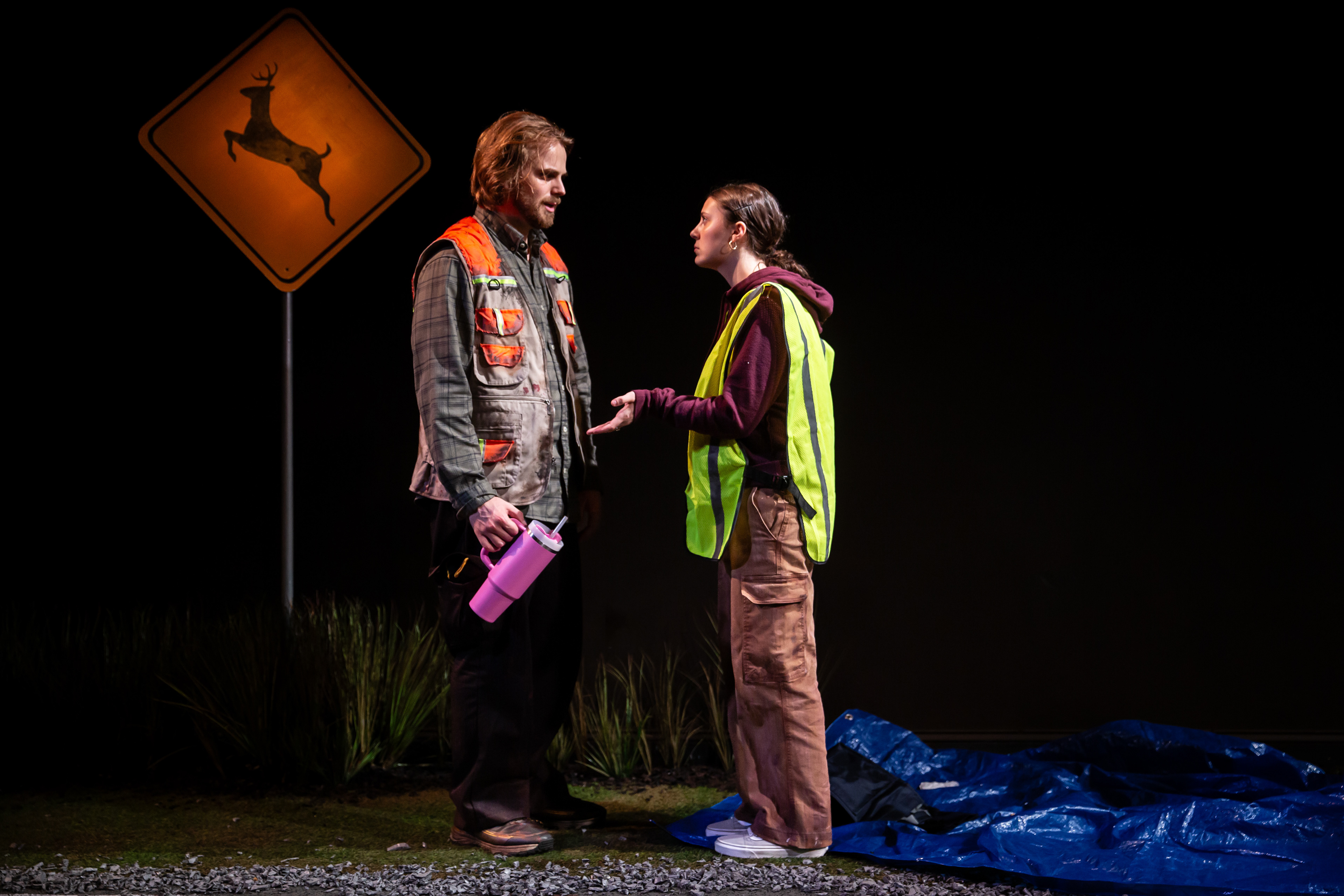


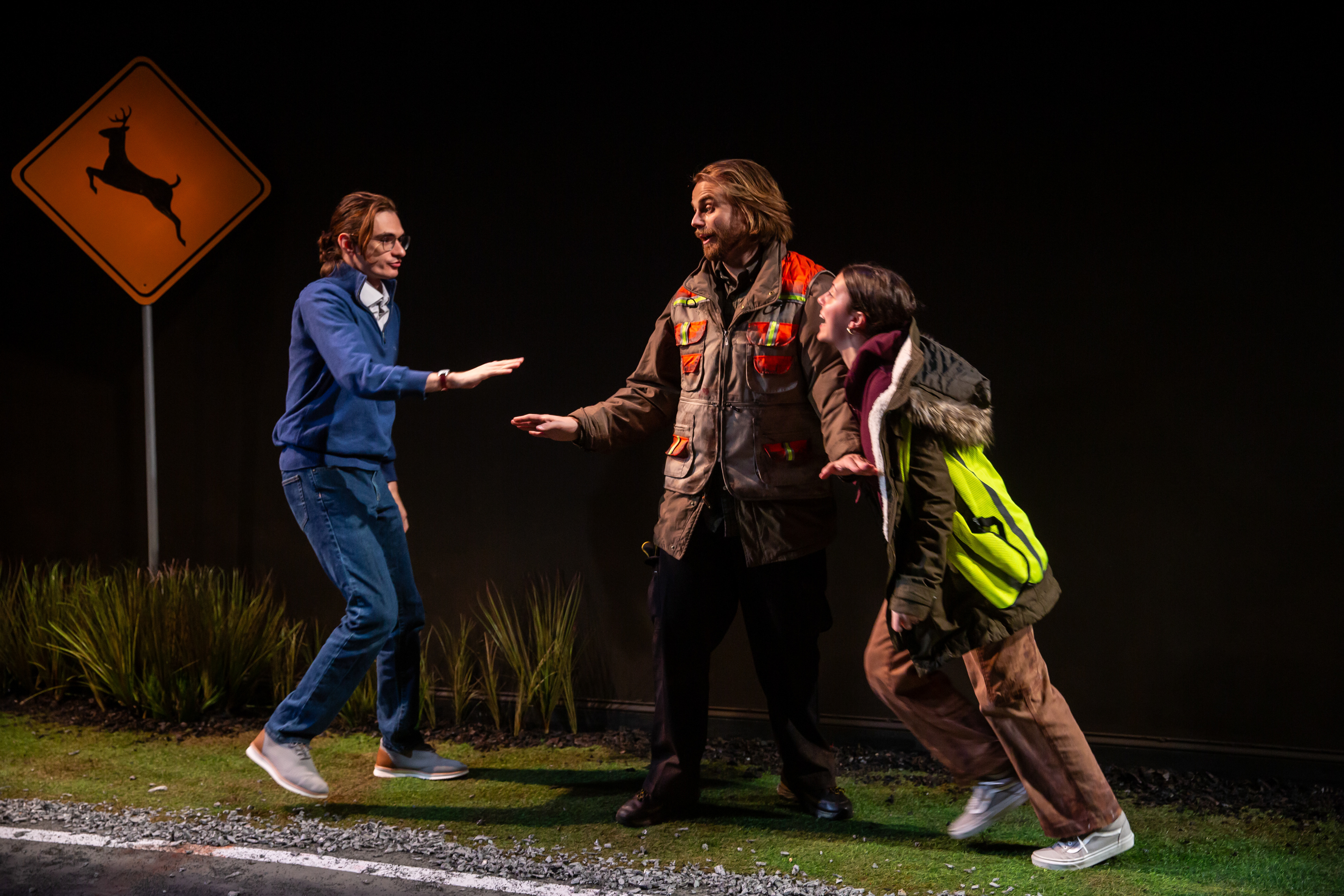
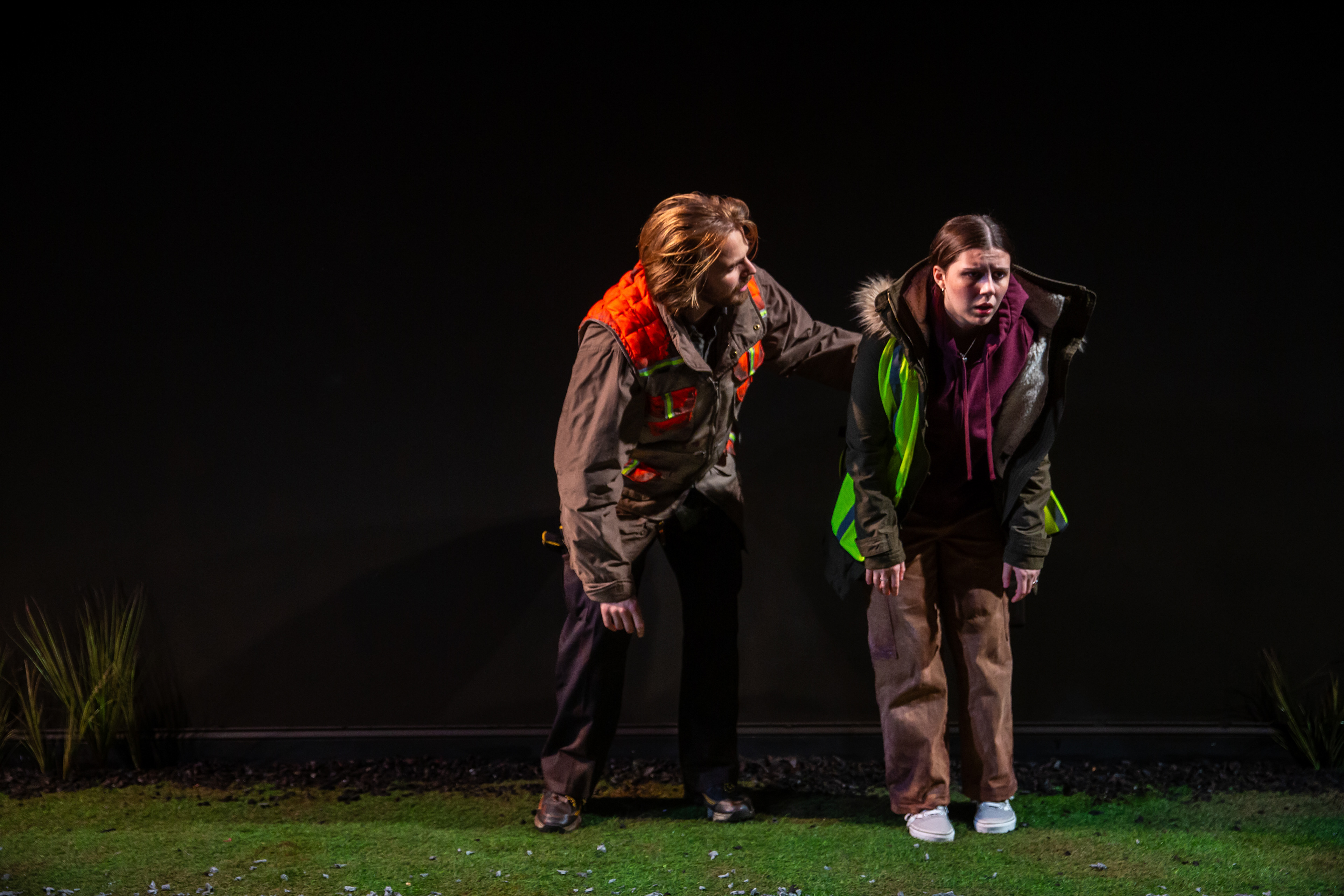
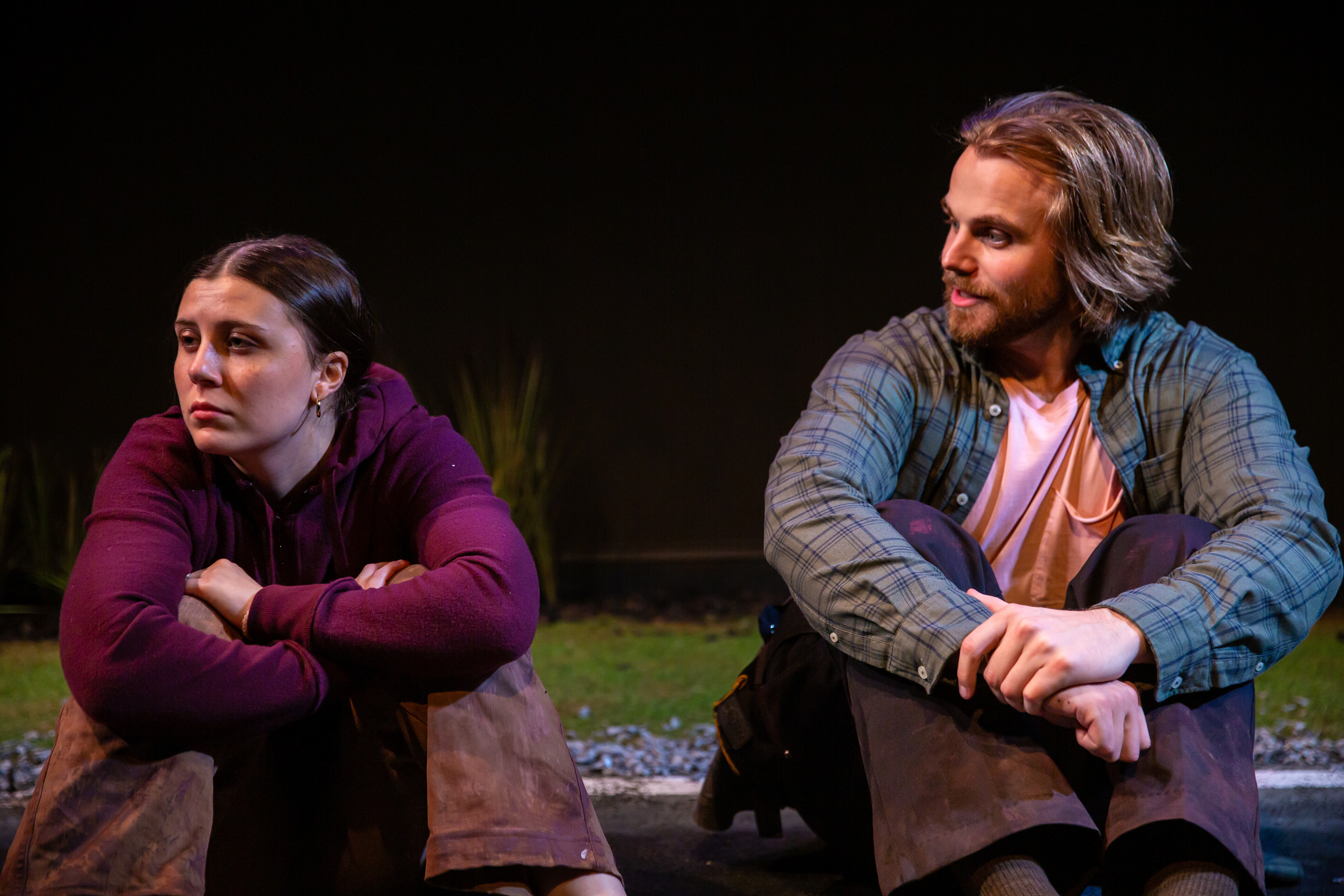
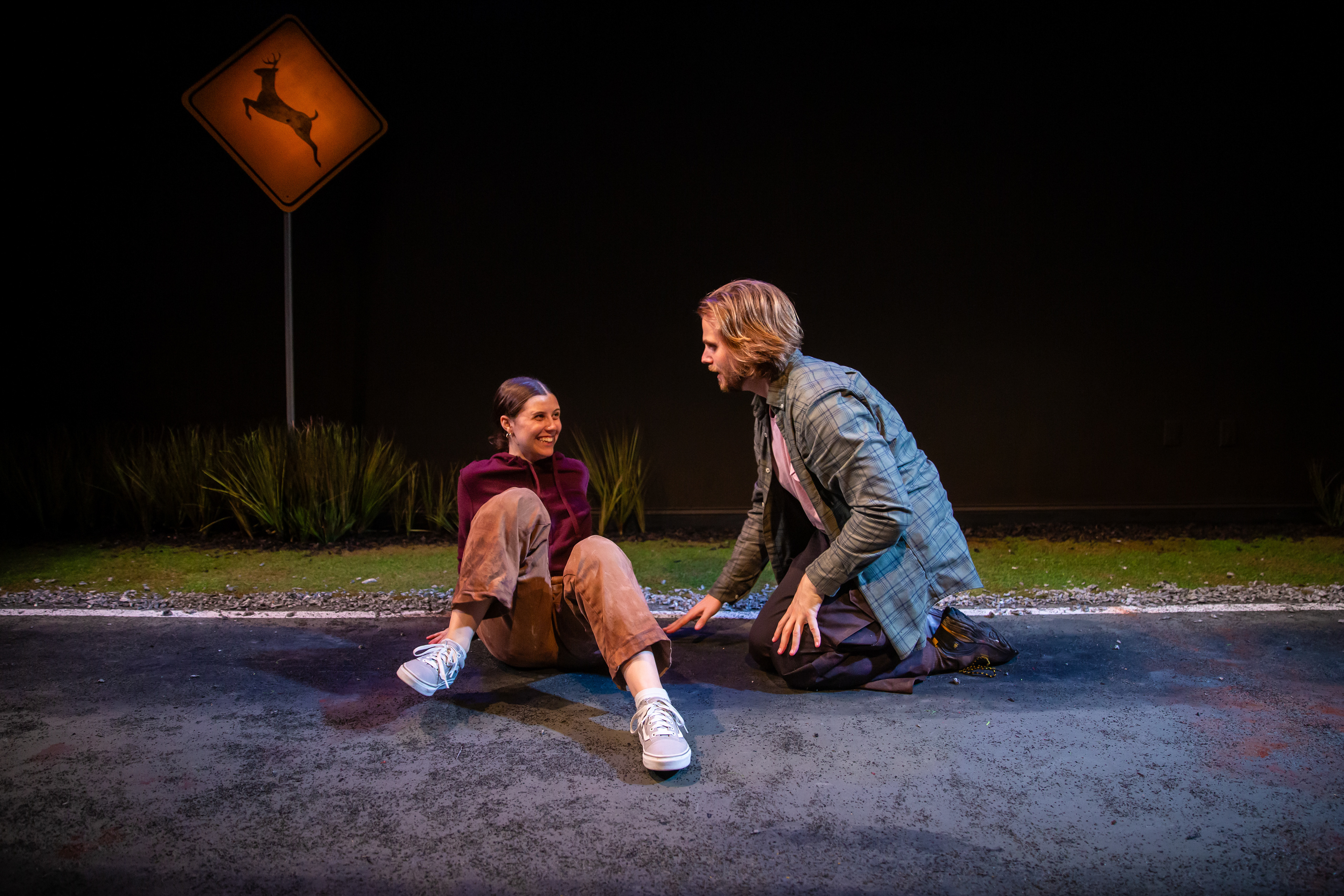
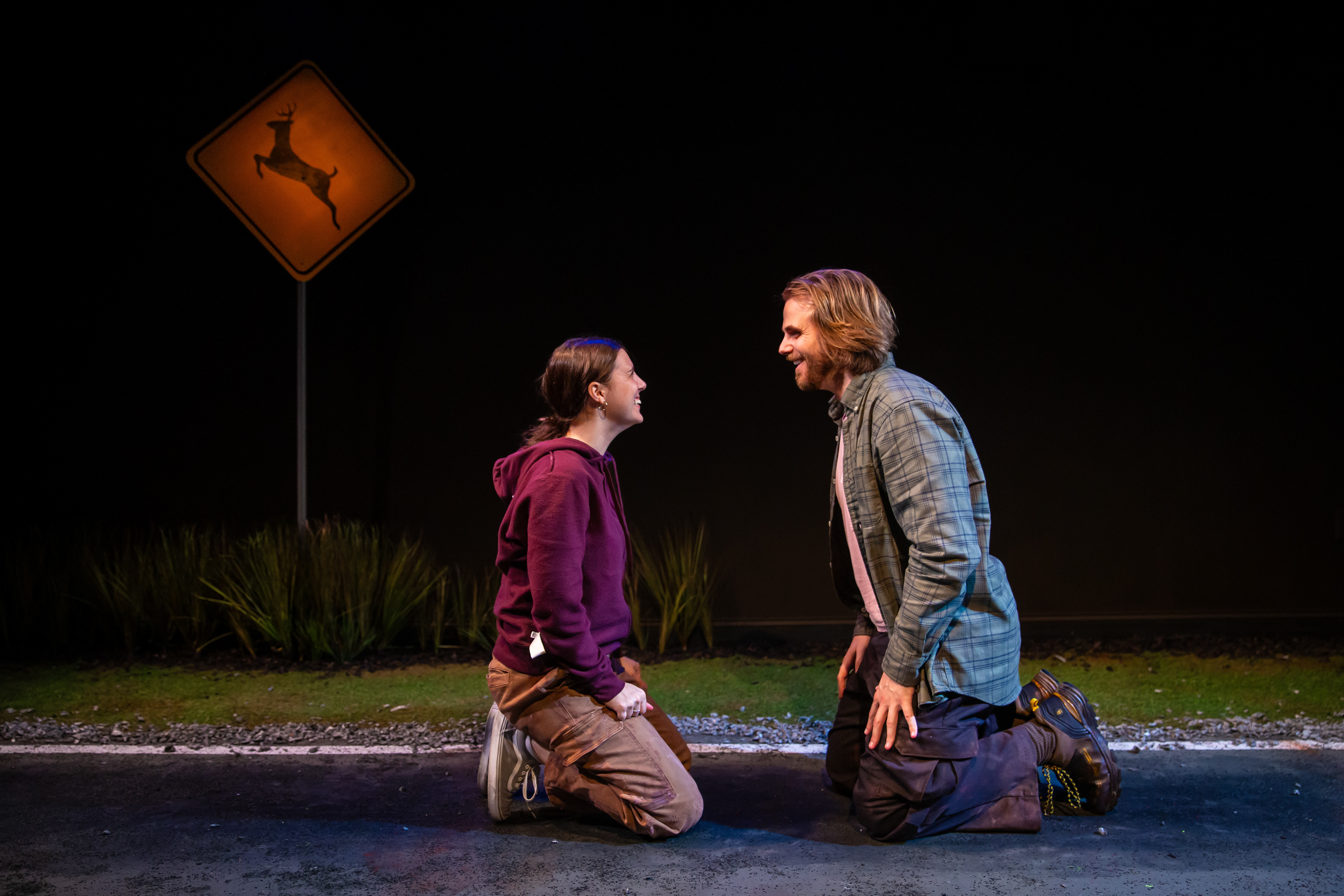
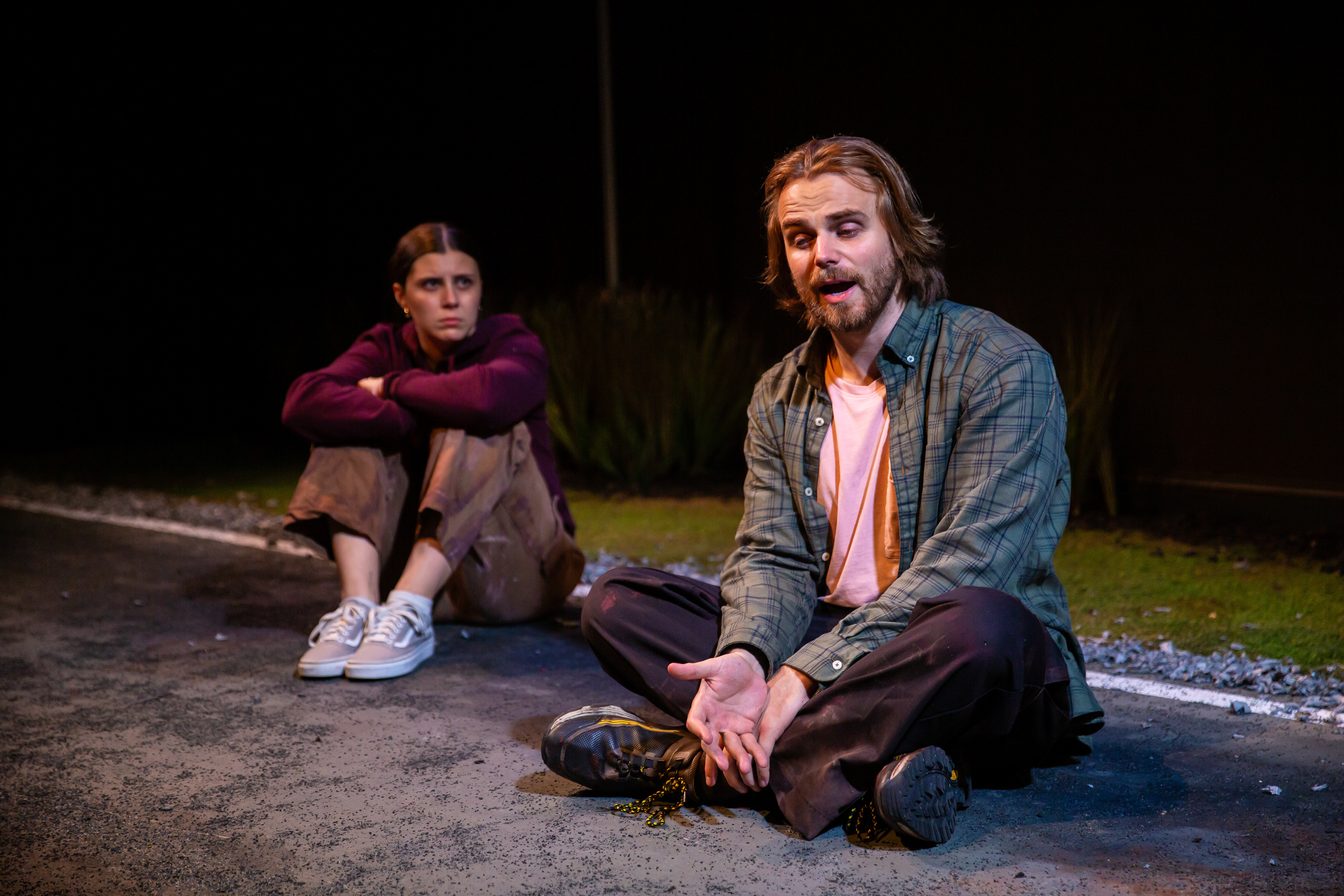

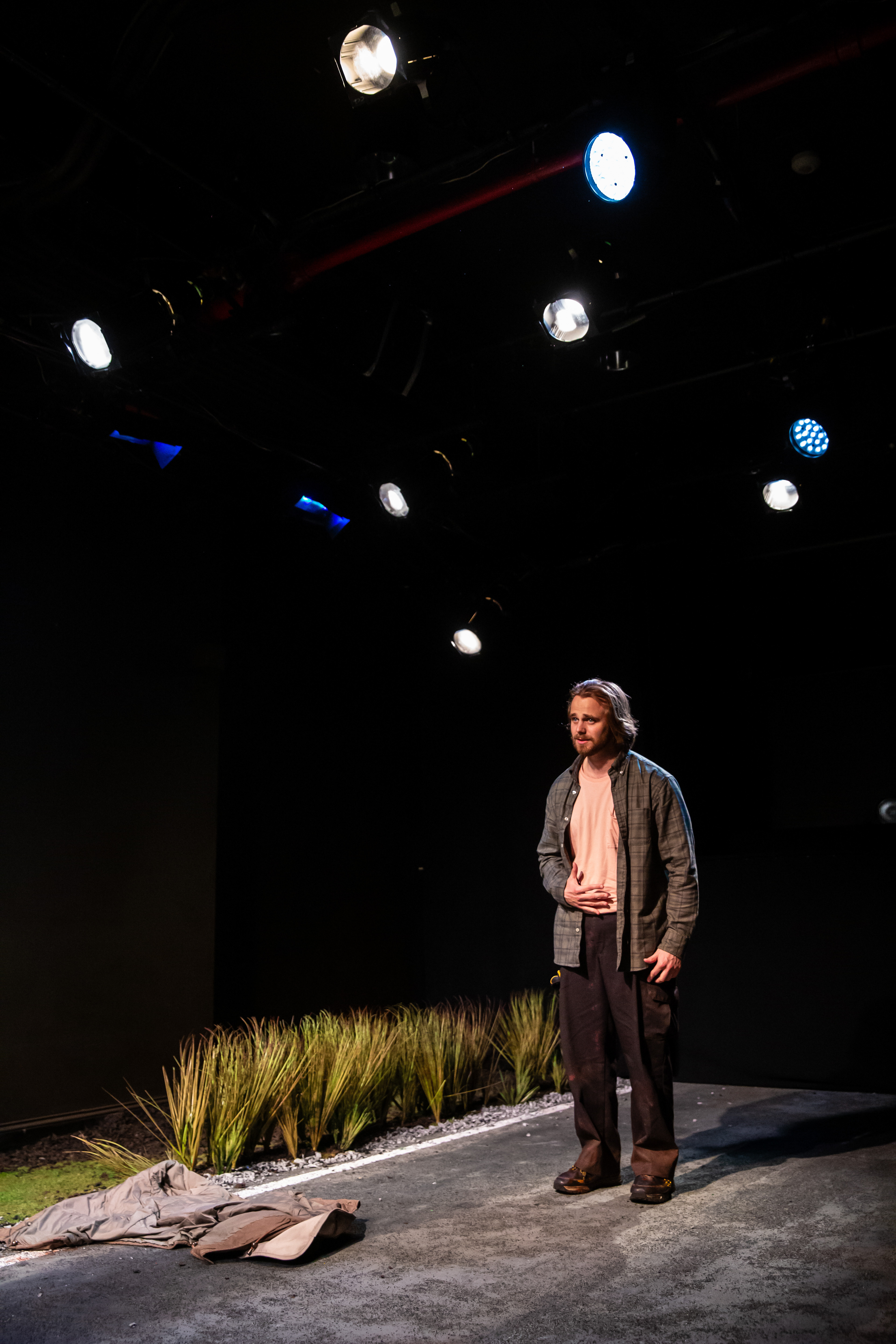

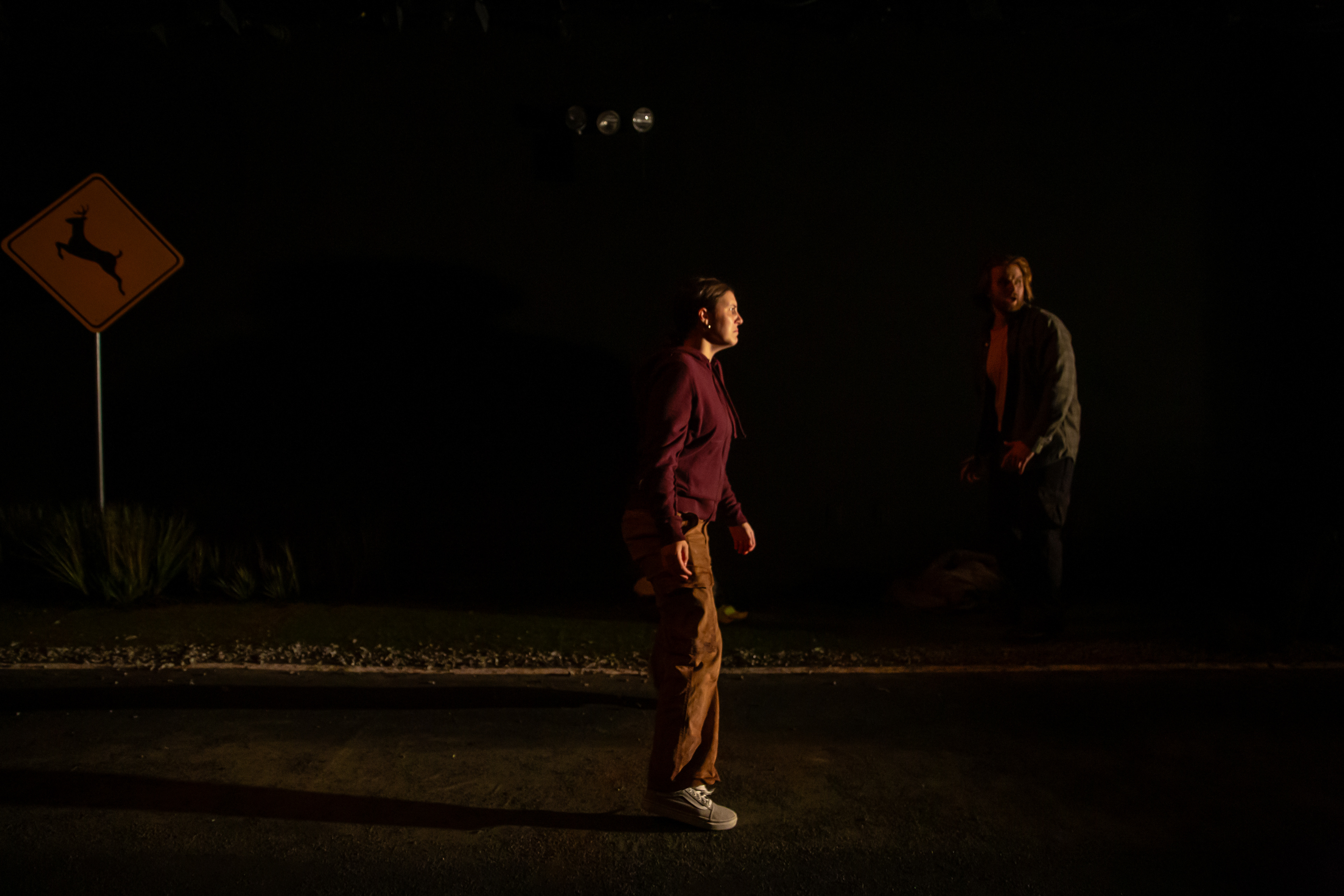
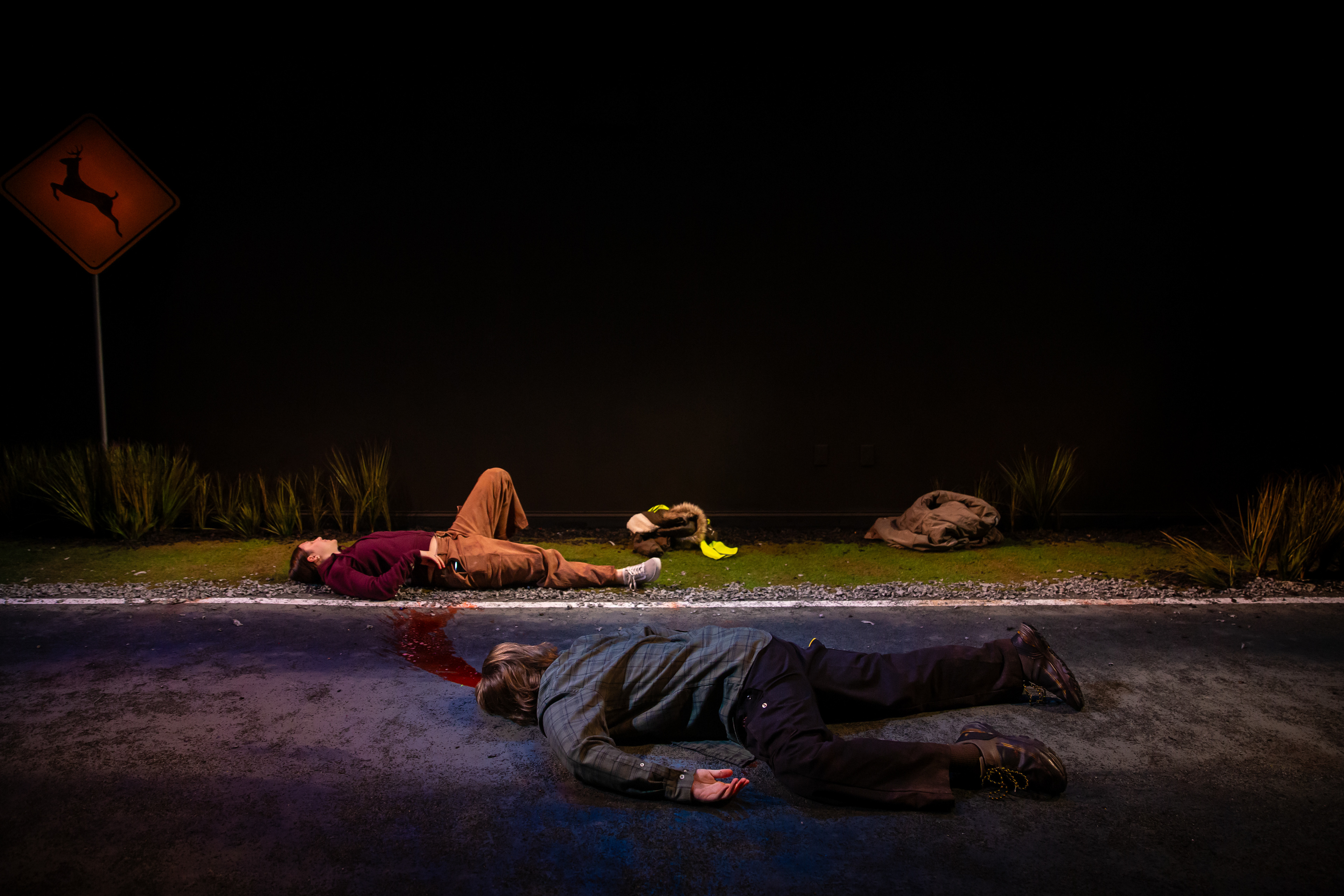
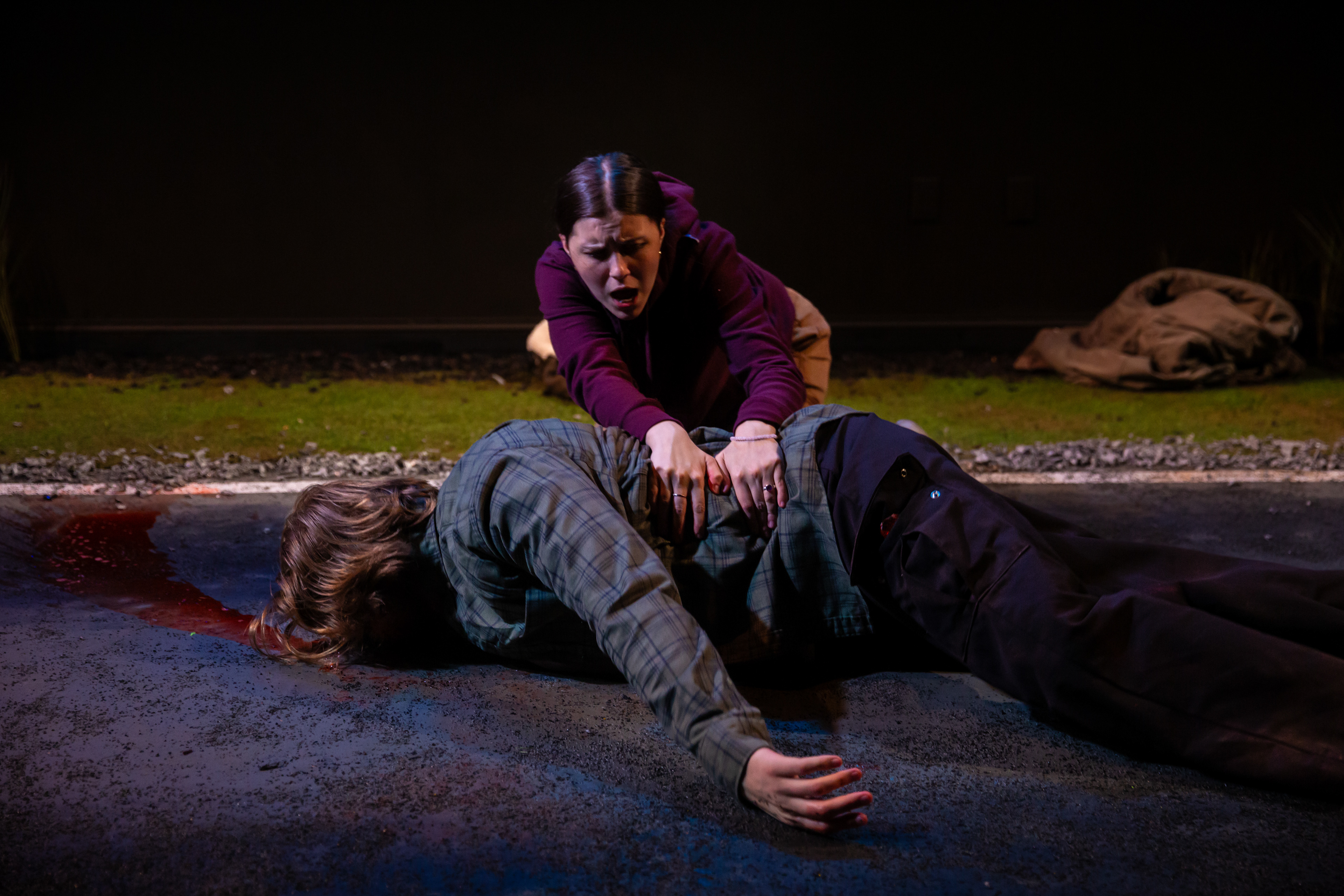

PRODUCTION REVIEW
"If you want your theater with an A24 vibe, this is your show."
"Nina Goodheart's guignol production does wonders."
"McIntosh knows how to orchestrate her shock."
– Helen Shaw, theater critic for The New Yorker
"This is a major piece of writing. It’s huge and risky and sad and powerful.
It feels like reading a classic for the first time."
– Gracie Gardner, Culturebot
"A preternatural master of mood, Goodheart reassembles some of the cunnicularii team (including Milliken) to create a similarly cinematic effect. Paige Seber’s lightning comes in striking flashes or gradual, ominous fades. The pink Stanley cup which costumier Saawan Tiwari provides Jaki conveys just about everything necessary to get on her page. And between each scene, Max Van’s sound sketches each roadkill’s demise through disembodied cabin conversations, sketching portraits of the casual recklessness Owen has deigned himself to clean up."
"It wouldn’t be a McIntosh play if it didn’t also acutely explore women’s impossible circumstances. This thread is pulled towards the end of the 80-minute production, almost as a bonus tie-in to the rest of her growing (and consistently excellent) oeuvre. Until then, Road Kills doesn’t coast, so much as journey imperceptibly through thematic terrain that might seem to bend, but which the writer’s firm hand navigates straight through."
– Juan A. Ramirez, Theatrely
"In a lesser production, these moments might feel like mere connective tissue—practical stage business designed to cover transitions. Here, they become meditative pauses, underscoring the ritualistic monotony of the protagonists’ work while subtly echoing the thematic undertow of the piece. The sound of tires skidding, the sudden thud of impact, the fading echo of a car accelerating into indifference—each auditory tableau renders the moment of an animal’s demise with stark specificity, yet without sentimentality. It’s not melodrama; it’s inevitability.
The production embraces minimalism not as a budgetary necessity but as an aesthetic choice. Junran “Charlotte” Shi’s set is marvelously unassuming—a strip of road, a patch of grass, a lone 'deer crossing' sign—but in its sparseness lies its eloquence. Each scene begins with the discovery of a new carcass, courtesy of Sean Frank’s tragic-end props. Sound designer Max Van and lighting designer Paige Seber orchestrate these transitions masterfully, creating a cinematic sense of immersion. Under Seber’s clean, confident lighting, the stage becomes a liminal space: somewhere between nowhere and everywhere. Saawan Tiwari’s costumes are a constant confirmation of Midwestern cold. Goodheart’s directorial hand is light but unmistakable. She threads the play’s humor and heartbreak with such precision that the tonal shifts never feel jarring, only inevitable."
"In a world where trauma is so often rendered as spectacle, this play dares to offer something quieter: the possibility that redemption may not come in the form of healing, but in the mere act of continuing. Of scraping the mess from the pavement, one piece at a time, and carrying on."
– Tony Marinelli, Theatre Beyond Broadway
"If I was dazzled by the humble yet genius set, I was blown away by Paige Seber’s lighting and Max Van’s sound design. Each scene is a Saturday of Jaki’s community service, separated by a blackout, plunging audiences into a car on a dark road, accompanied by the voices of drivers speaking as they hit an animal. The soundscape combined with a differing burst of headlights for each crash pushes the boundaries of what can be created on stage."

